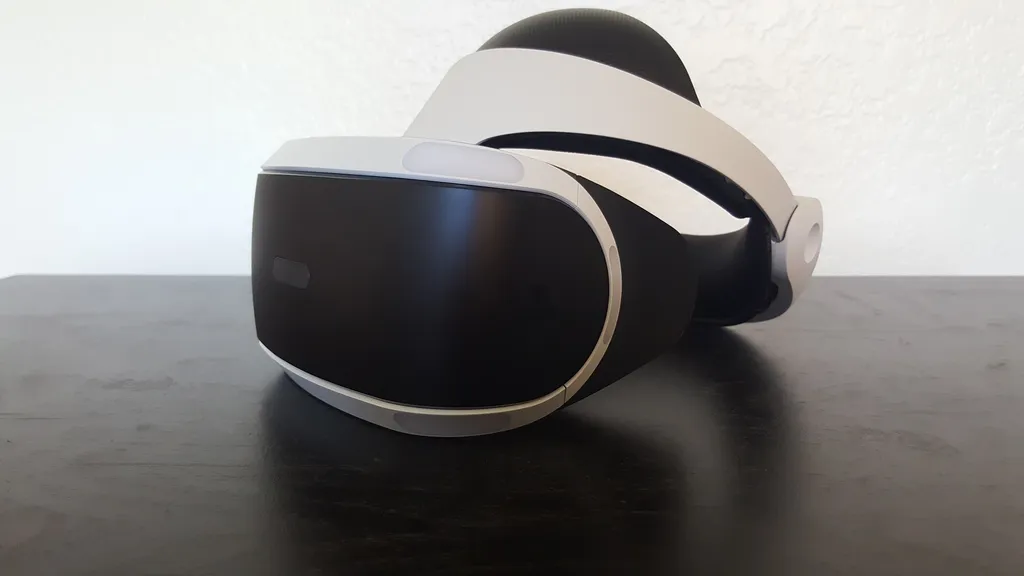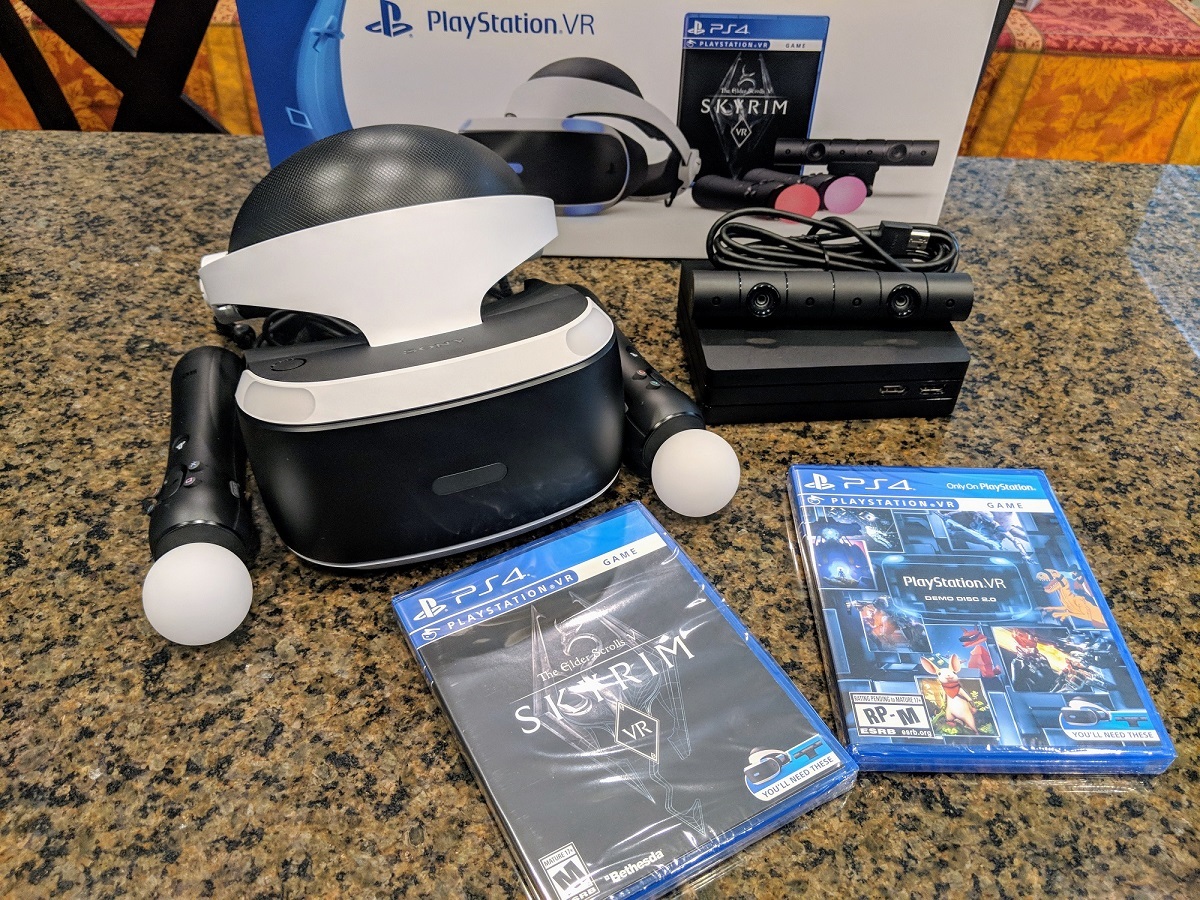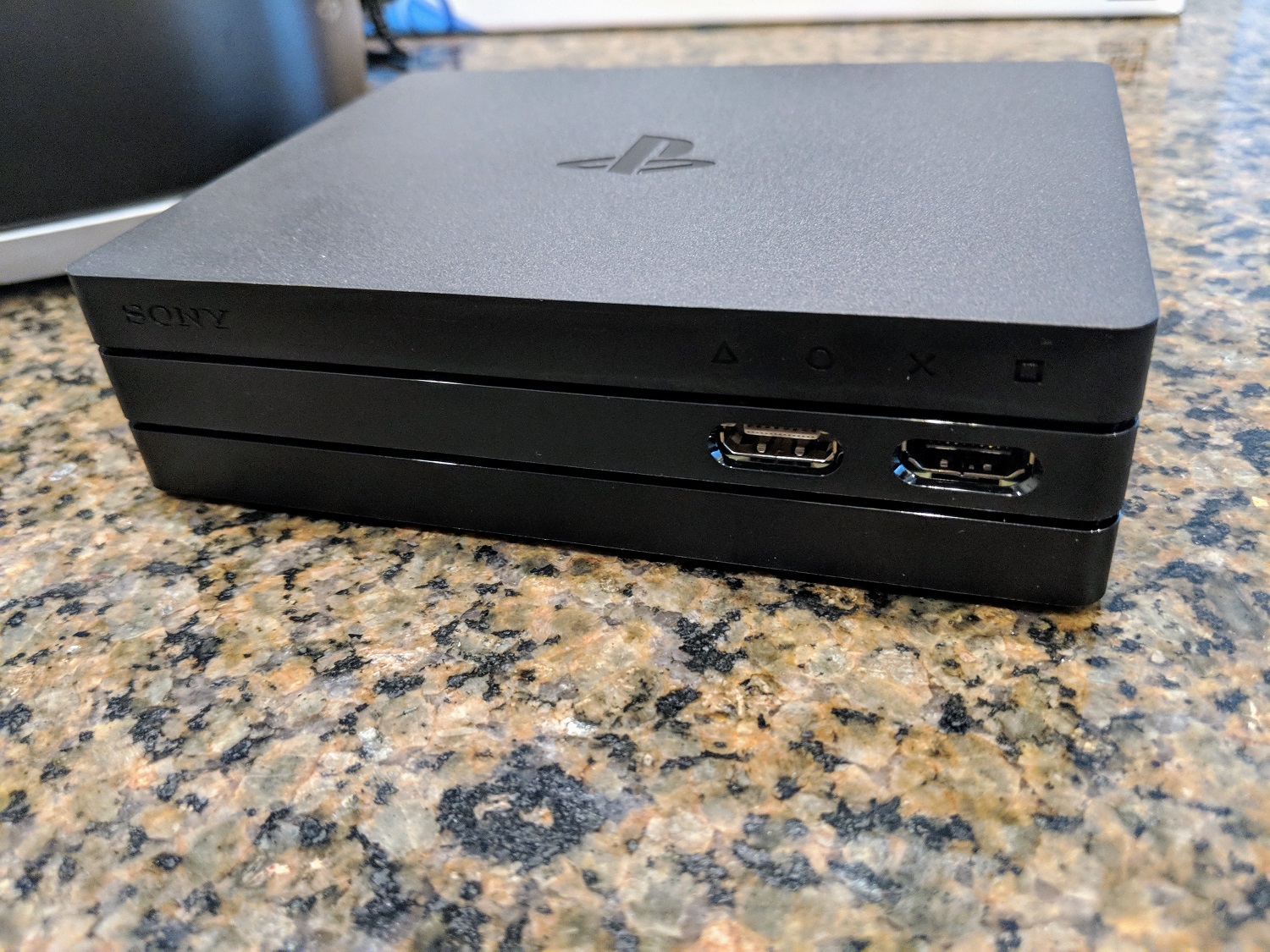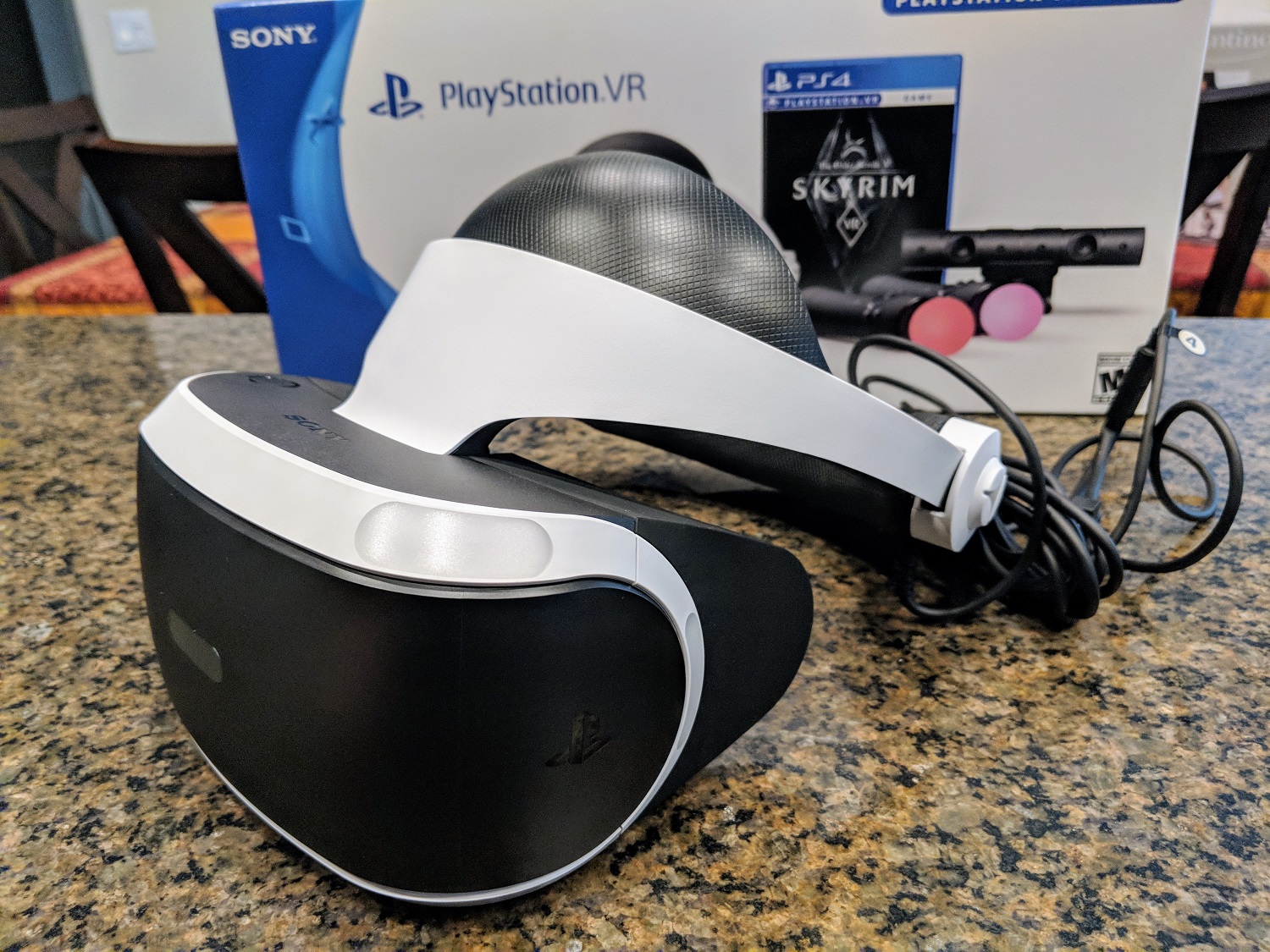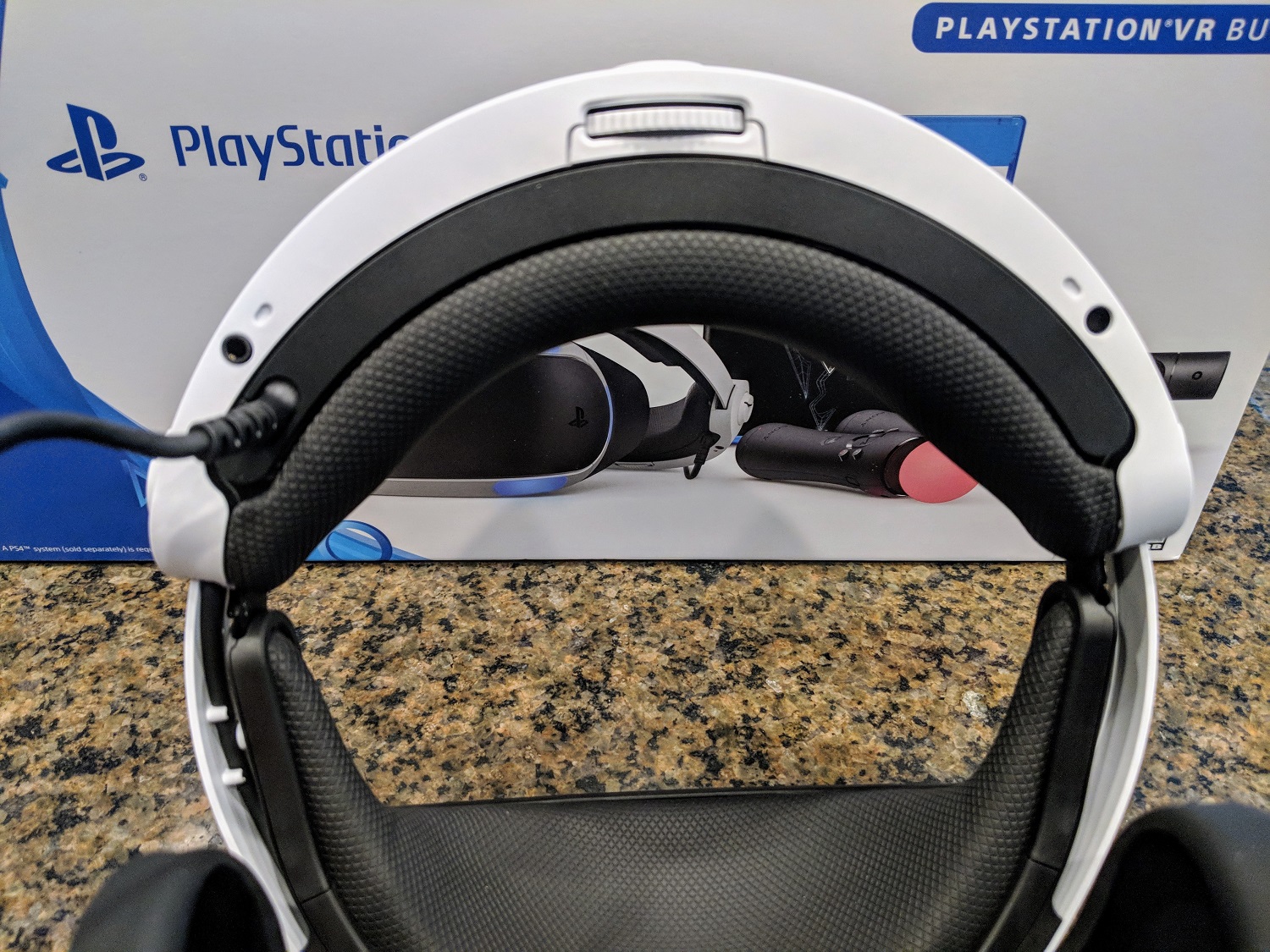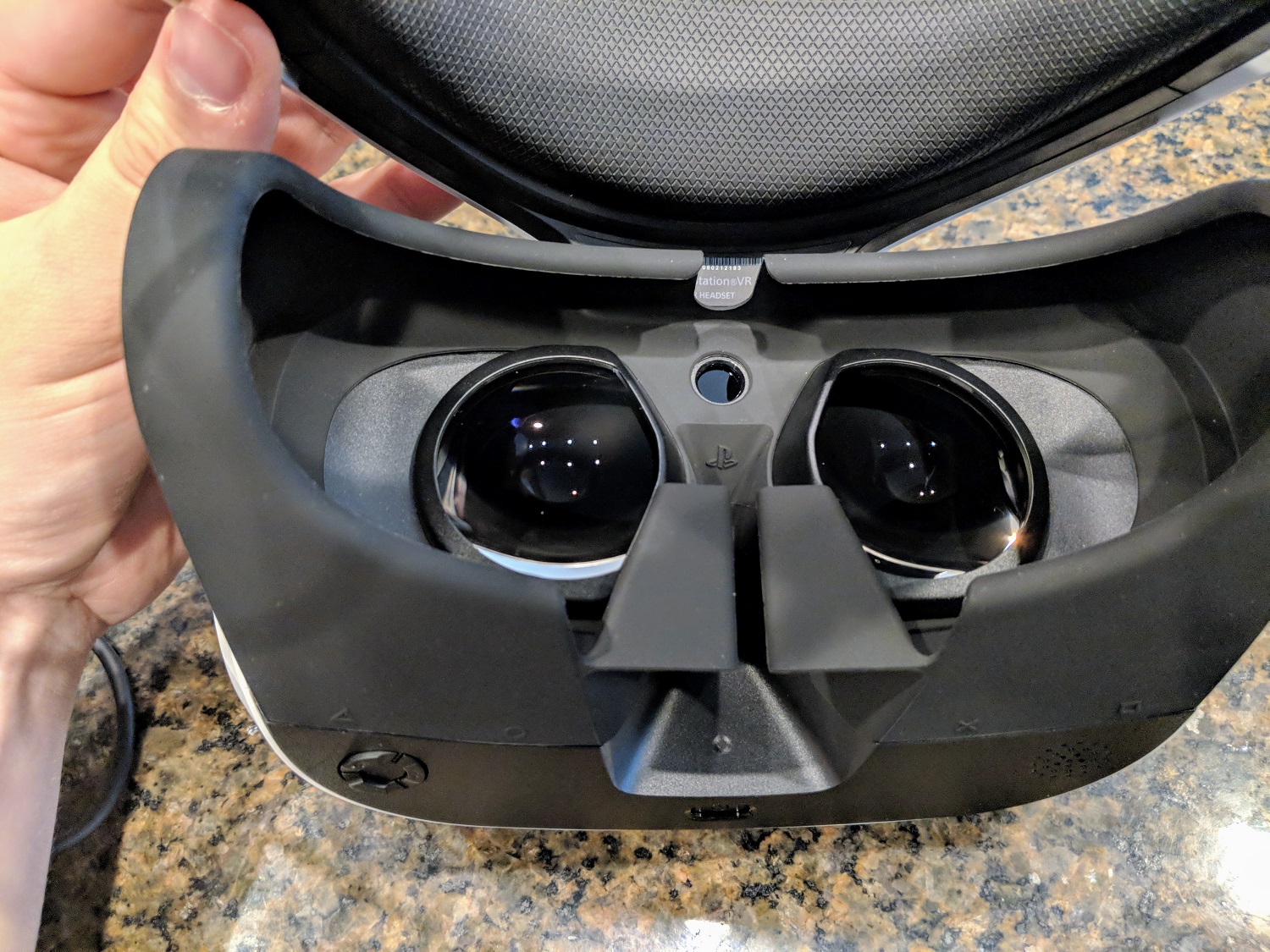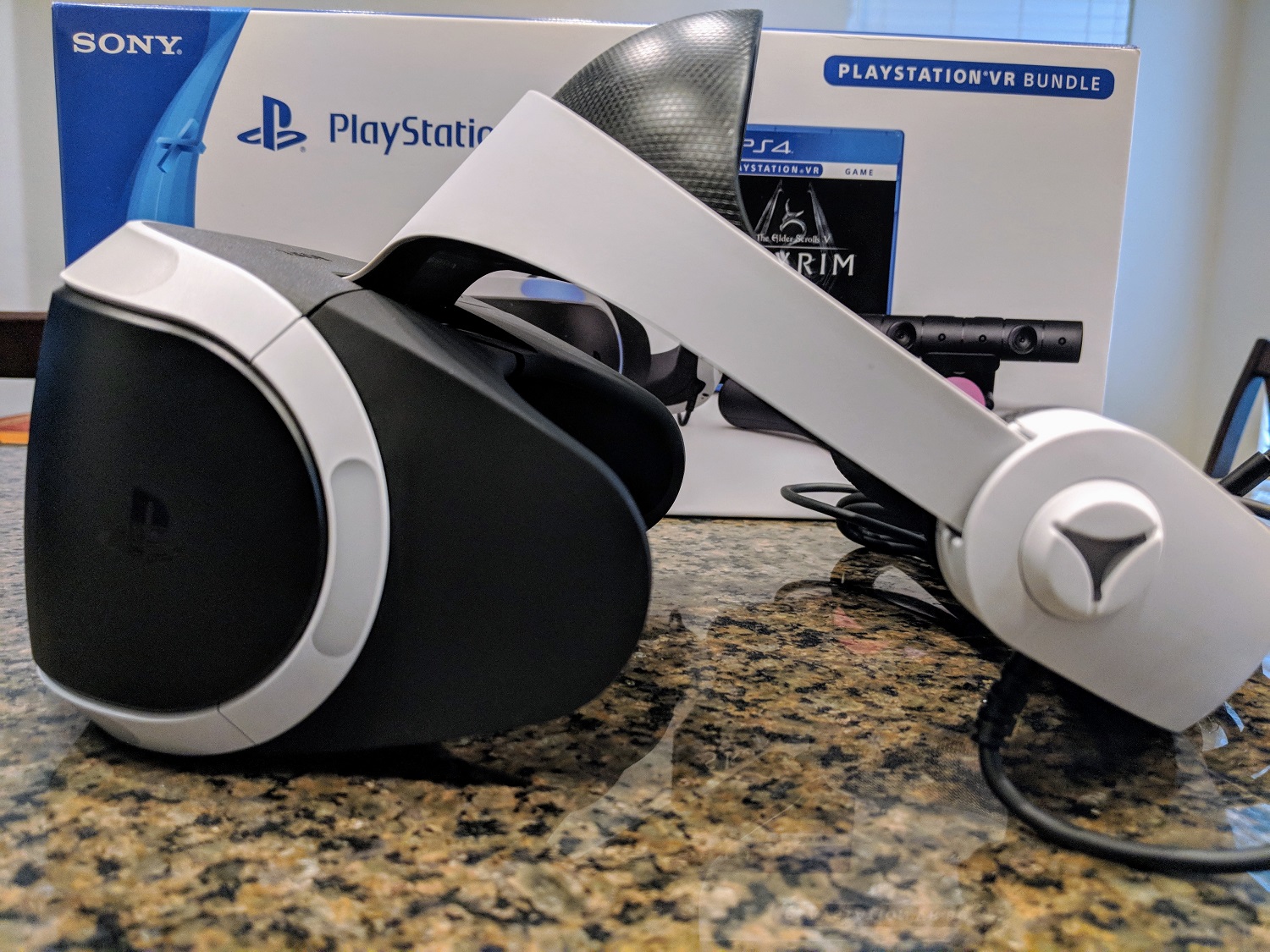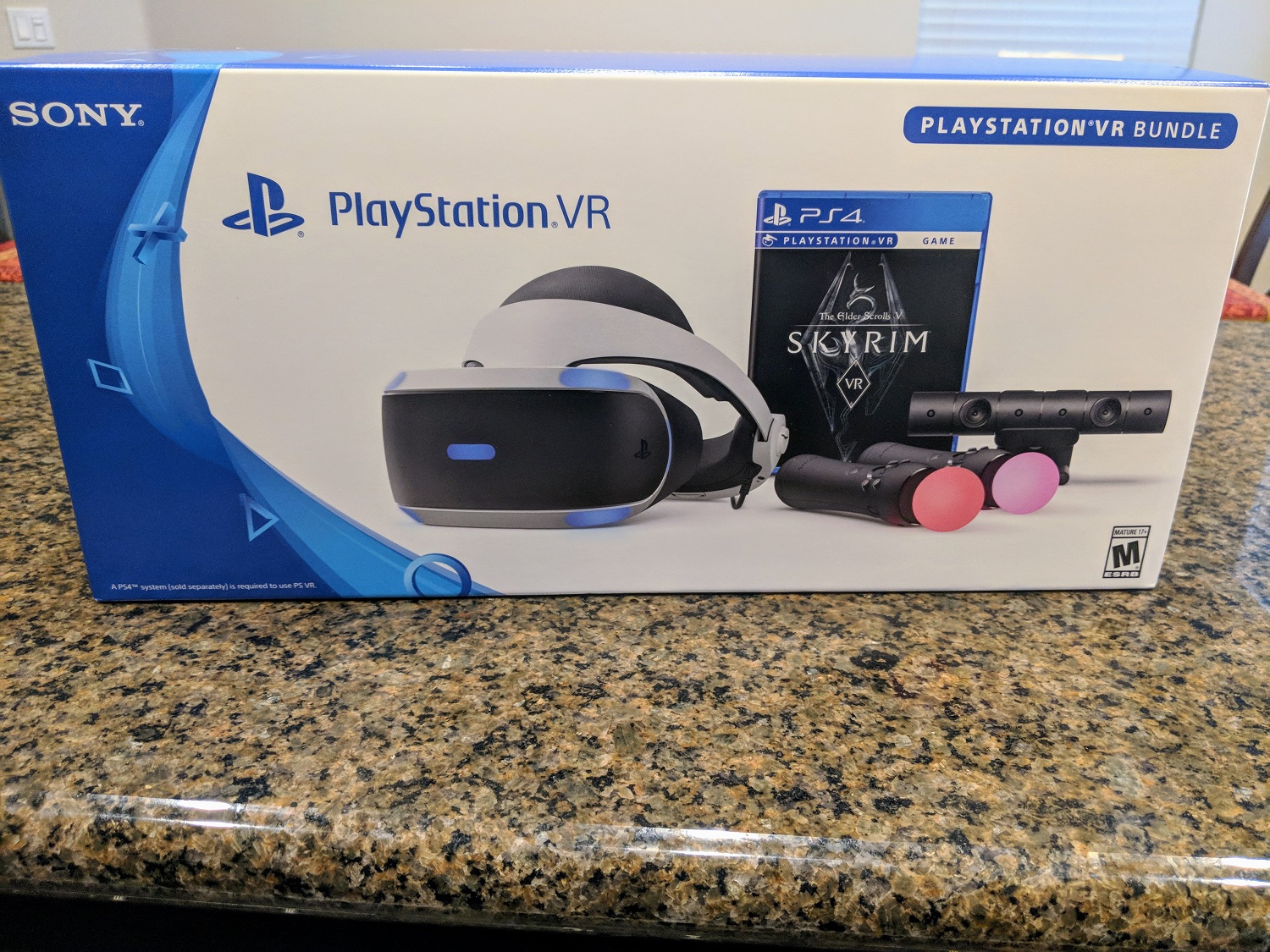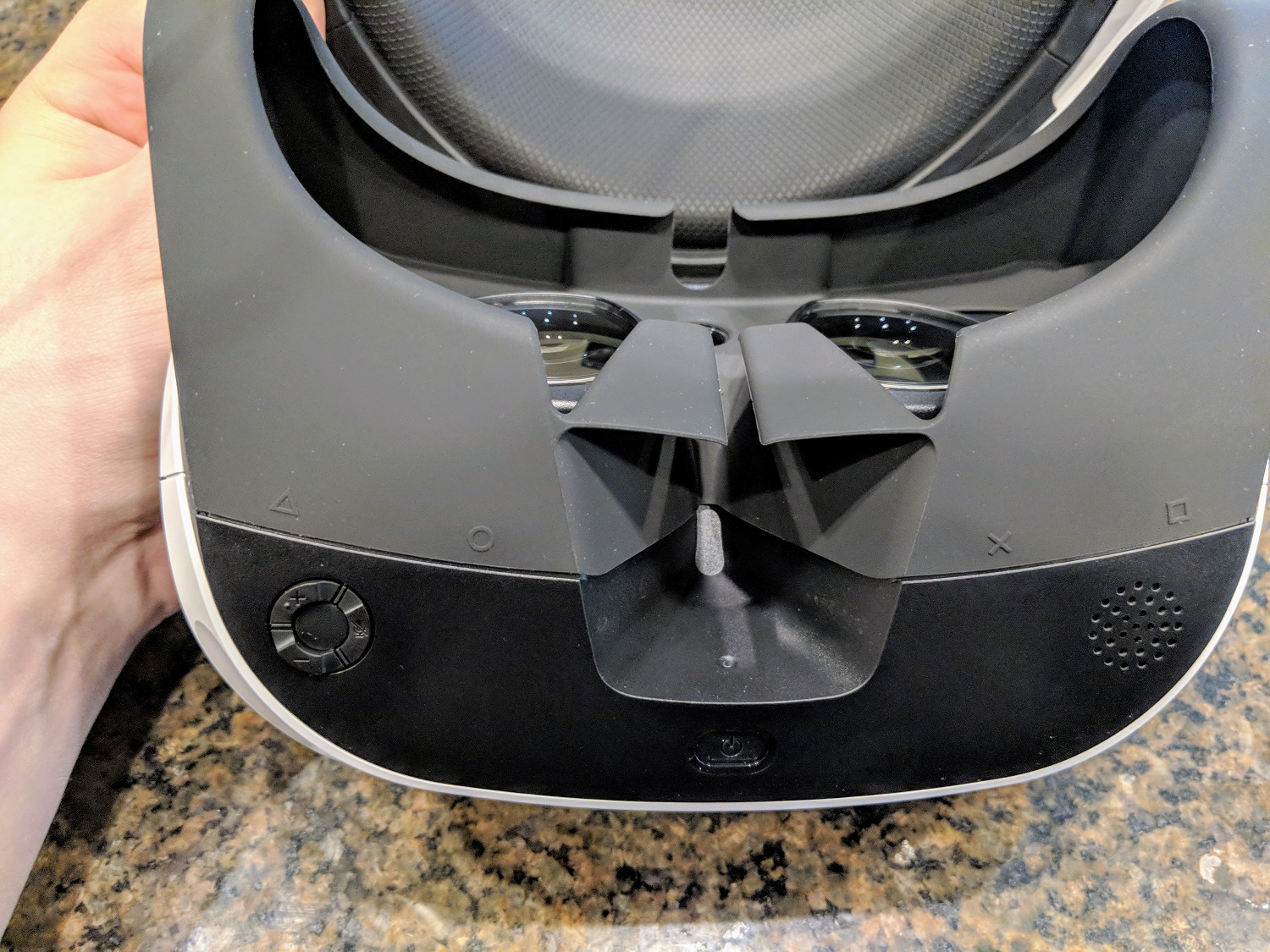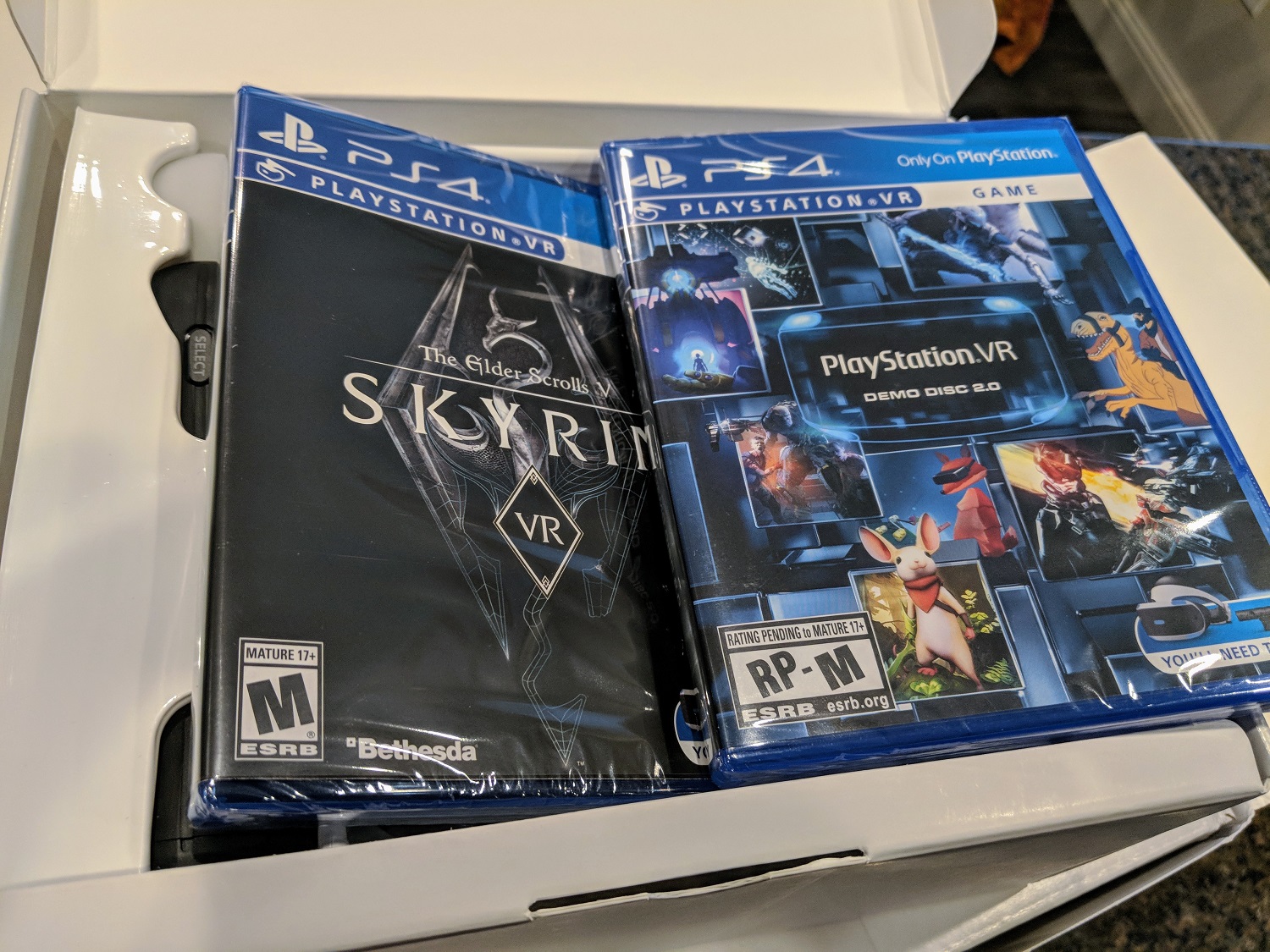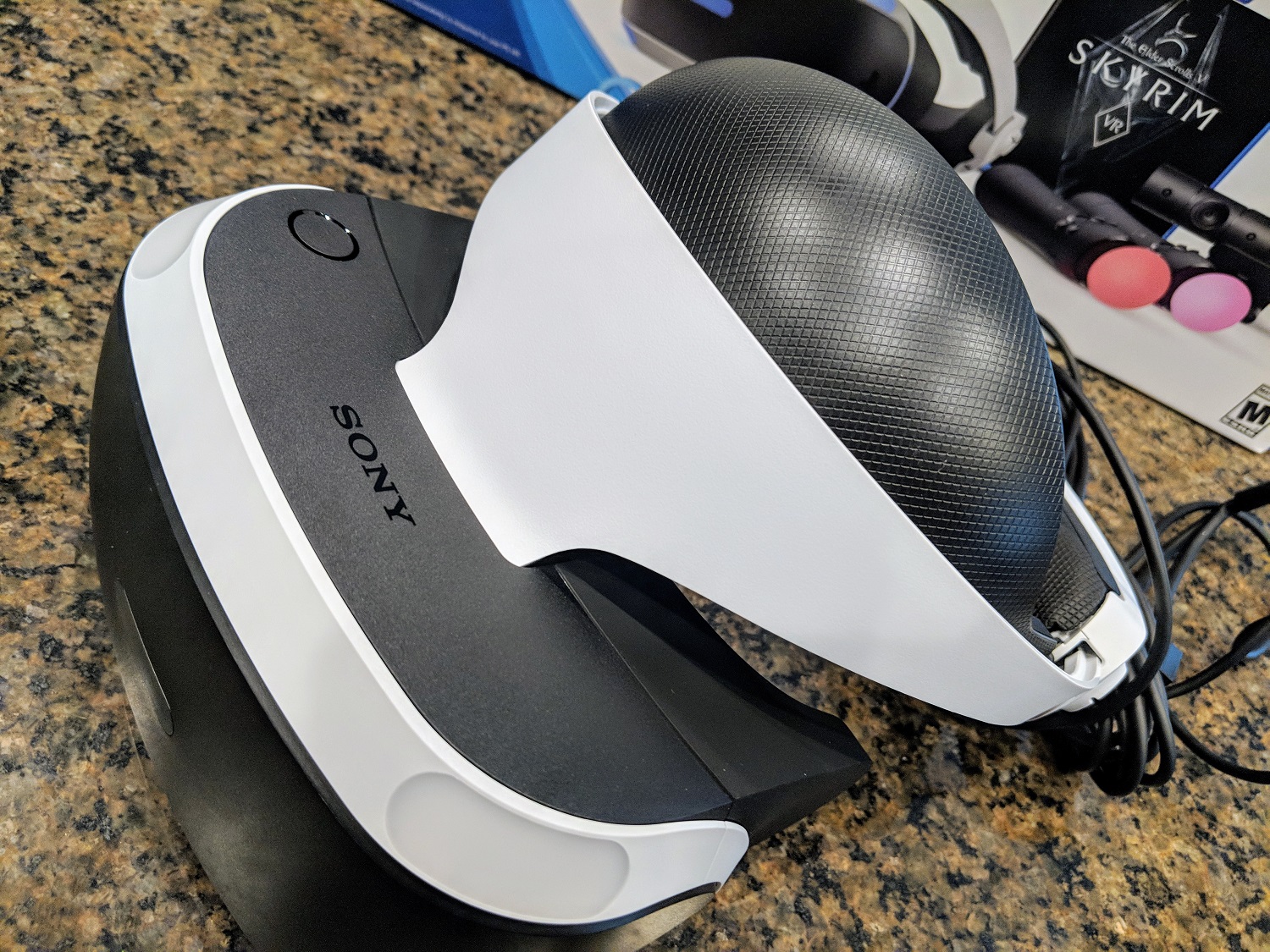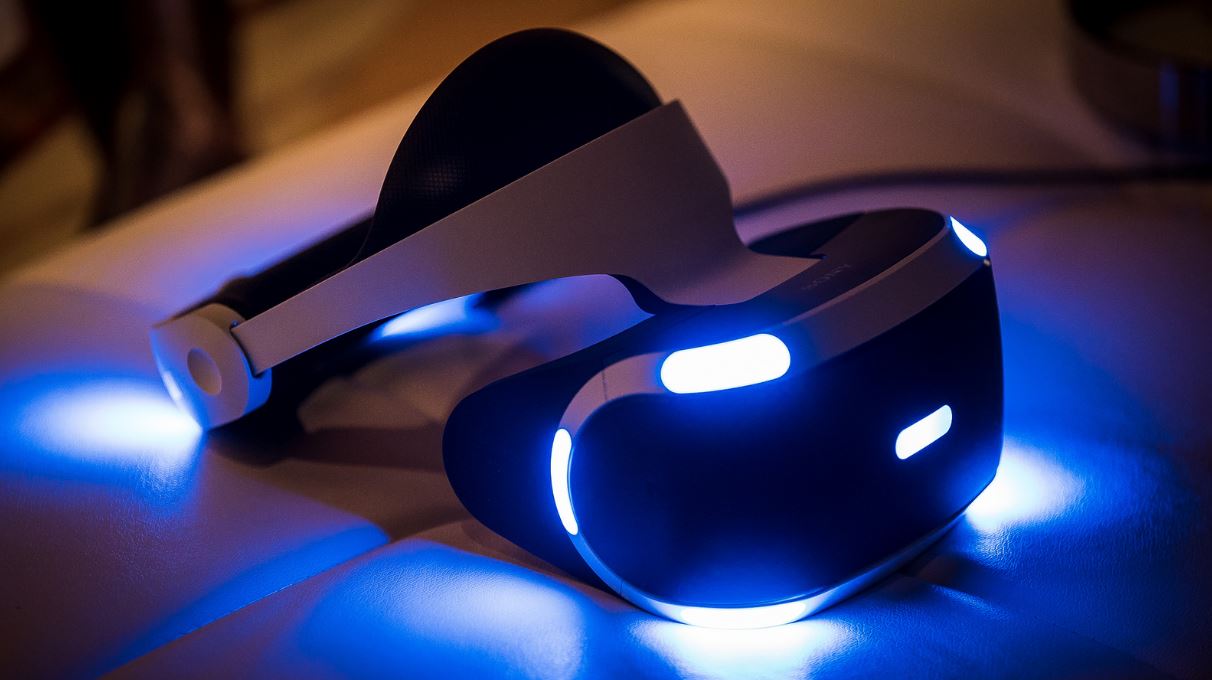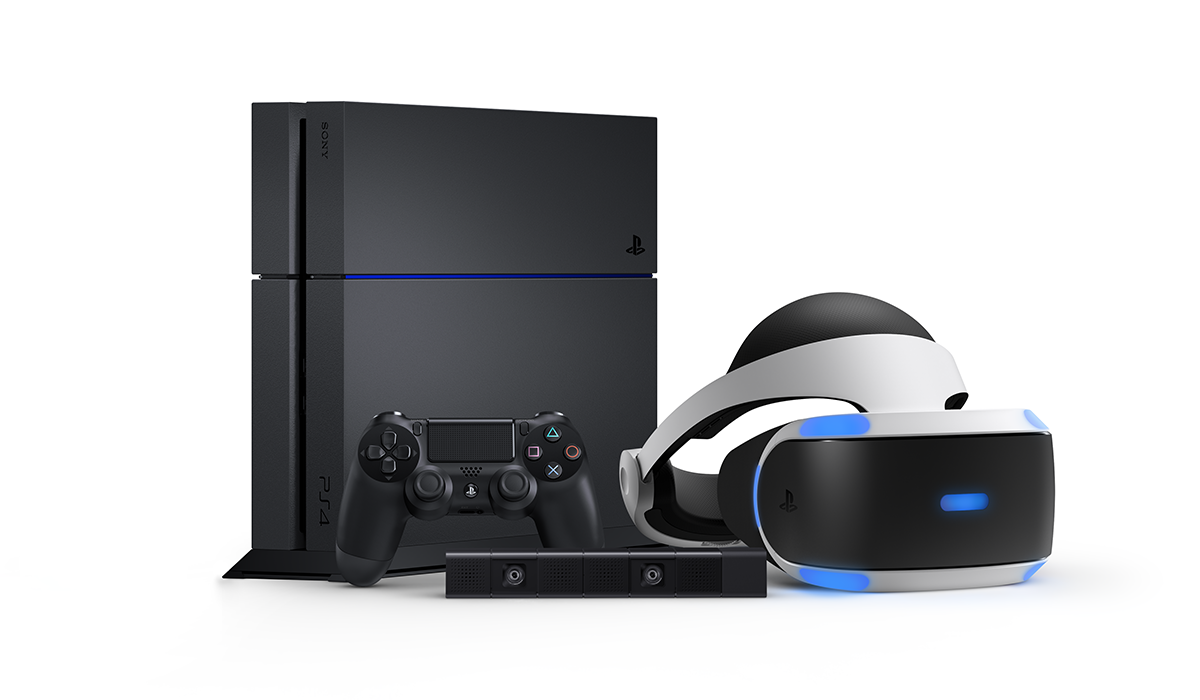November 2017 Update: It’s been over a year since the PSVR originally released to the world and in that time a ton of awesome games (here is our list of favorites) have released that take full advantage of the power of VR. This week, on November 17th, 2017, Sony is releasing a brand new CUH-ZVR2 model of the PSVR headset that’s almost identical to the first one, but has a few key differences.
First and foremost the processing unit that plugs into your PS4 both looks different and acts a bit differently than the original model. While plugged in it will now enable HDR pass-through, which means you won’t have to unplug your processor unit and PSVR any time you want to use HDR with your 4K TV. This was a big headache for me personally since I have a PS4 Pro and couldn’t have HDR access and PSVR access all at once.
For review purposes, Sony sent us the upcoming Skyrim VR PSVR bundle, which includes the new headset, new processor unit, a PS4 camera, and two PS Move controllers. This particular bundle also has the new PSVR demo disc physically in the box, but you can get all of the demos for free on the PSN Store too. You can see some unboxing photos here:
The only other major differences with the new PSVR model are mostly cosmetic. The button to slide the visor in and out is on top of the headset now, instead of on the underside. You plug headphones into the bottom of the PSVR’s base instead of into the inline box on the cord near your chin. This is nice because it gets the cords out of the way a bit. Volume and mute buttons are also on the underside of the PSVR headset now, too. And the last noticeable detail that’s changed is that the cord is no longer in two parts. Previously, you’d connect a short cord from the PSVR to a longer cord that connects to the processor unit. Now, with the new model, it’s just one long cord from the headset to the processor unit. Other than that, it’s the same headset.
It runs the same software at the same quality level with the same lenses and padding as far as we can tell. If you already have a PSVR it’s not worth upgrading but if you’re in the market for one I’d recommend grabbing one of the new bundles that includes it already. Other than that, you can see the rest of our review below for our thoughts on the hardware itself!
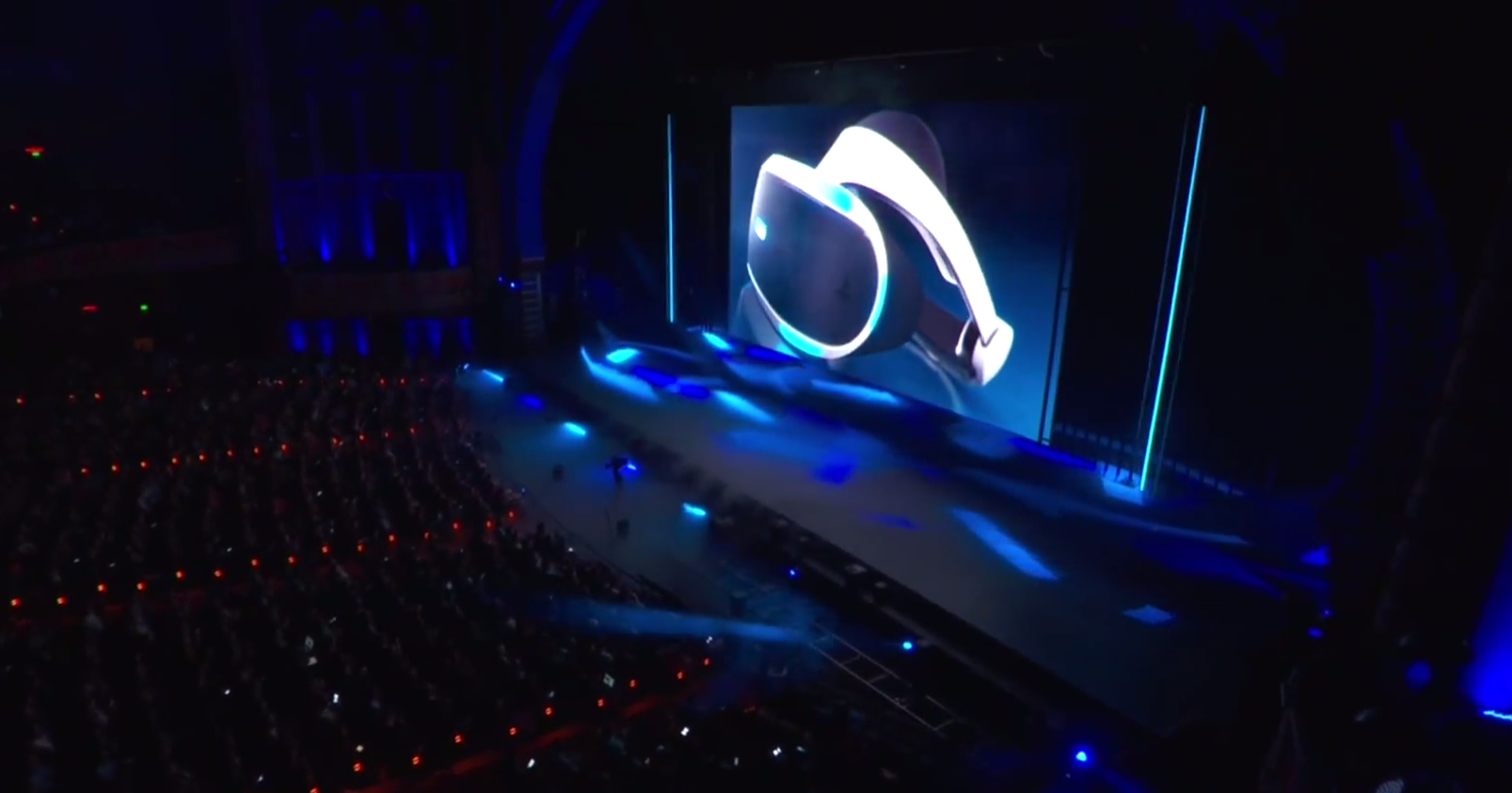
Original Review: Did you know that the PlayStation was born from a botched business deal with Nintendo? Sony and Nintendo were all set to release a collaborative game system known as the SNES-CD back in the 90s as an add-on device for the Super Nintendo. The deal went south, we were eventually treated to Zelda-based nightmare fuel via Nintendo’s replacement deal with Philips instead, and Sony eventually went on to create the PlayStation as a result. The best-selling console of this generation, the PlayStation 4, which has moved well over 40 million units since release in 2013, was all made possible by the Big N’s change of heart over 20 years ago. Funny how that works out, isn’t it?
Sony helped usher in the era of disc-based console games on the PS1, added DVD-playback support to the PS2, built the PS3 using the now-dominant Blu-ray disc format, and is once again at the forefront of technology with their rapid adoption and ferocious endorsement of virtual reality. Next week, the PlayStation VR headset (formerly known as Project Morpheus) will release to the world on October 13th and tens — perhaps even hundreds — of thousands of gamers will have their hands on a device with the power to transport them to fantastical worlds never before possible, all from the comfort of their tried and true PlayStation 4 game consoles. No beefy, expensive PC required.

That may seem a bit long-winded, but that was intentional. The “Reviewers Guide” for the PlayStation VR headset Upload received from Sony a week ago includes a timeline (shown above) of the console manufacturer’s history, including blips for not only the PS1-PS4, but the PlayStation Eye Camera, the Move wands, and more. It’s been a long time coming and now Sony is finally putting all of its wacky peripherals to use in one immersive experience.
The PS VR headset is admittedly weaker in power than its higher-end competitors, the Oculus Rift and HTC Vive, but its also more affordable and is squarely focused on the established marketplace of PlayStation 4 console gamers. A defined market with ease of access shouldn’t go understated.
Now that we all know of what’s inside the box, it’s time to see how it all shakes out once it’s actually on our faces.
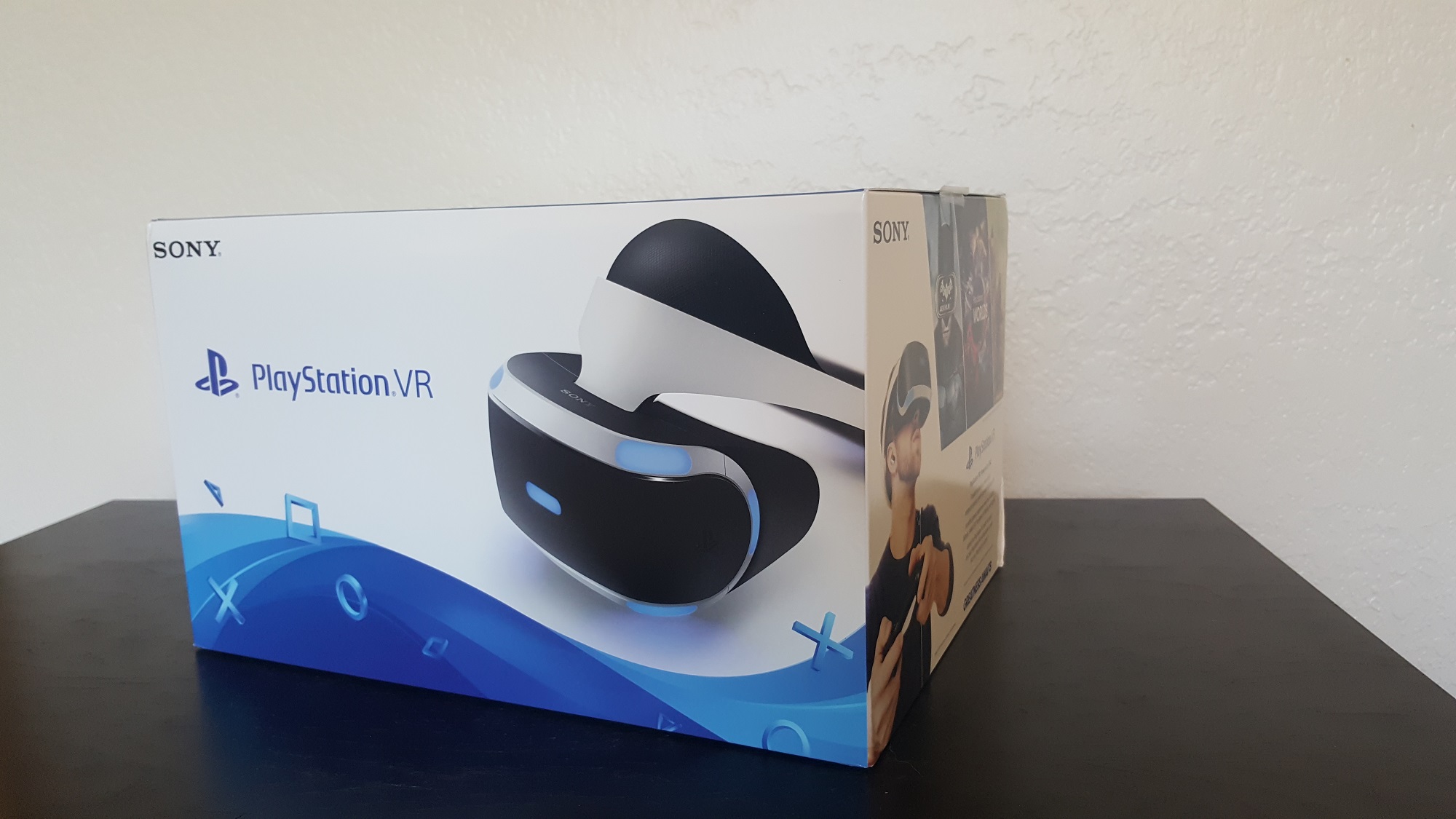
Table of Contents
Setup
Ergonomics and Design
Display and Optics
Sound
PlayStation Camera Tracking and Controllers
The Games
Other Features and Topics
Greatness Awaits
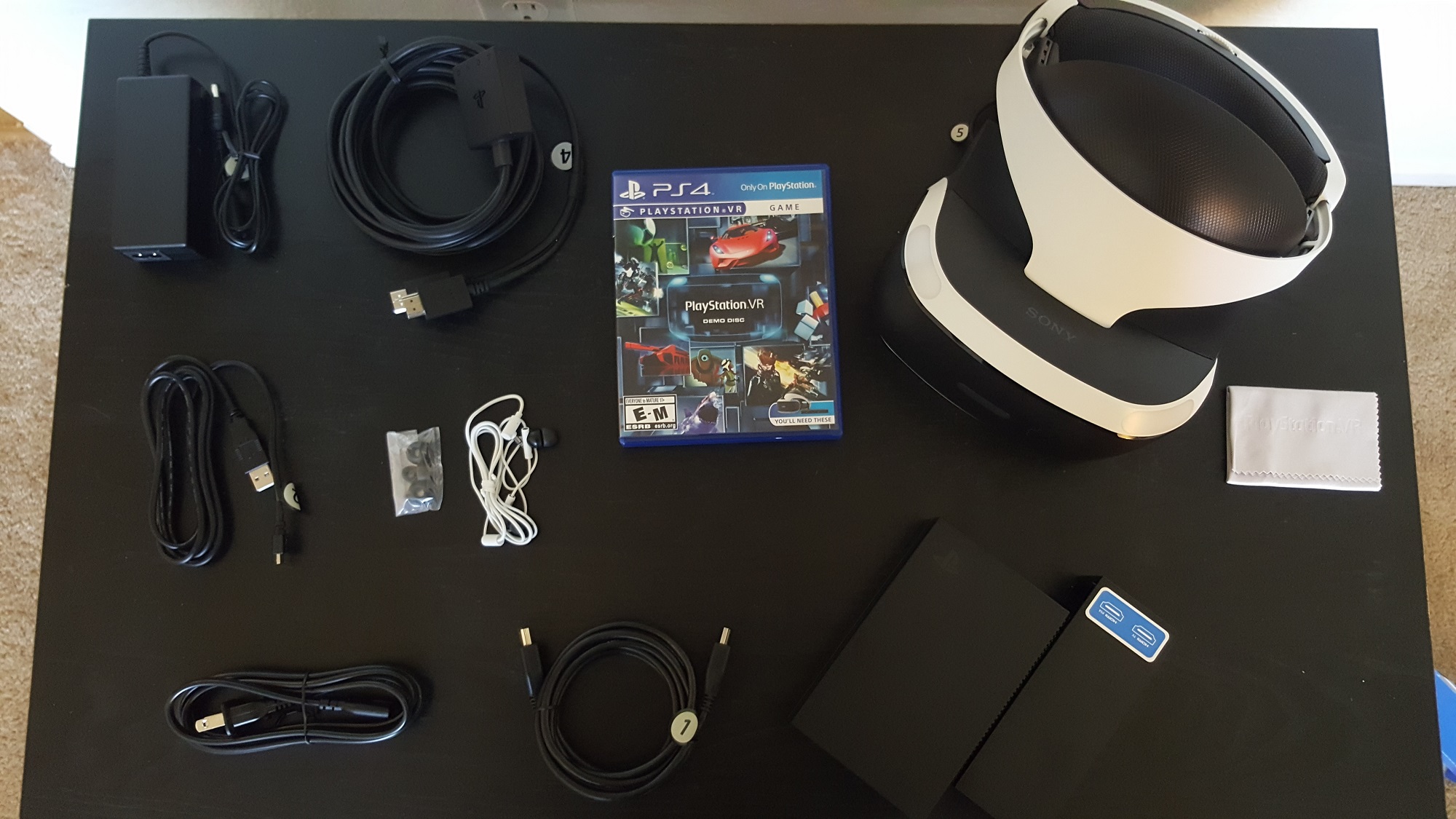
Setup
The PlayStation VR is relatively easy to setup. For the sake of simplicity, I’ll assume you already own a working PlayStation 4 that you use on a semi-regular basis if you’re reading this review. If you don’t and you’re woefully unaware of how home video game consoles work, let me break that down for you: you plug it into the wall, then into your TV. Probably into your modem or router directly as well. That’s pretty much it.
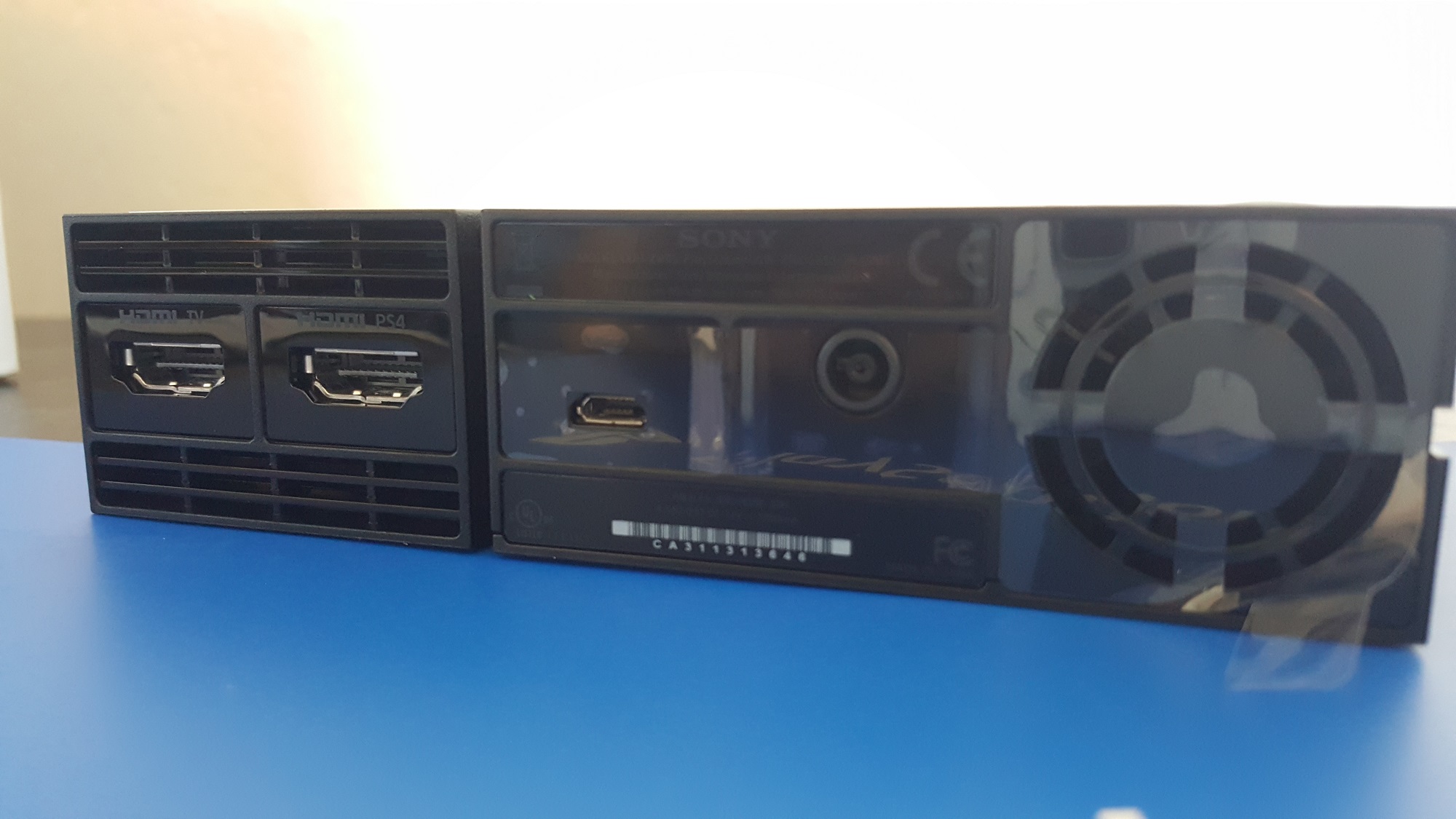
Once your PlayStation 4 is up and running, it gets a tiny bit more complex. Inside the PS VR packaging you’ll find a little breakout box, called the Processor Unit, that looks like a miniature PlayStation 4. One end of this unit you’ll plug it into your TV — essentially moving the HDMI cord from the back of your PS4, to the back of this device. Then you’ll also hook the device to your PS4 using another HDMI cord.
From there, you just plug the unit into the wall for power, then plug the headset into the other side to complete the connection. All of the cords are labeled clearly and it’s a simple system. The most complicated part is just making sure your cable management is good, since all of the added wires can lead to a lot of clutter. I set my breakout box directly on top of my PS4, but you’re free to place it somewhere else if you’d prefer.
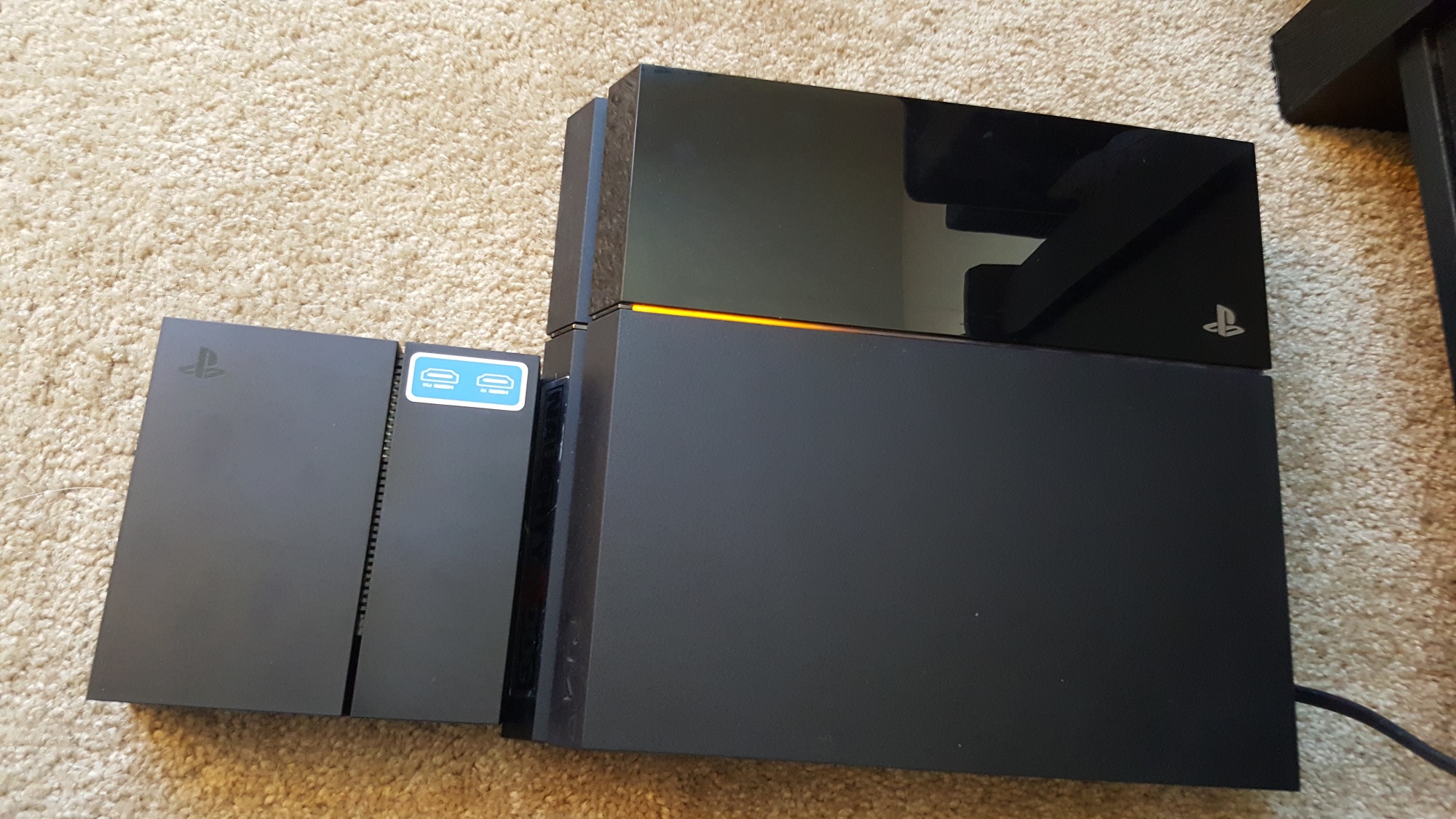
It doesn’t stop there, though, as you’ll also need a PlayStation Camera for the headset to function at all and the core unit packaging does not include one. A different, more expensive bundle does, or you can purchase one separately. If you don’t have one already, it just plugs into your PS4 system directly and sits on top of your TV. It’s relatively hassle-free overall. The box includes detailed instructions for setup if you get confused and there are already videos online.
Following that assortment of wires and cables, you can finish the setup process with a bit of software bootup. Click through the prompts on your screen and you’ll eventually start the calibration process. This is where things can get a little tricky, as Sony actually recommends sitting approximately 5-feet away from the camera with up to 5-feet of space behind you. This is partly to ensure you don’t hurt yourself by moving around blindly, but also partly due to the necessities of the camera to make sure it doesn’t get confused trying to keep up with your movement.
After all that, you’re good to go. The PlayStation 4 will handle updates, so downloading and installing new firmware isn’t necessary.
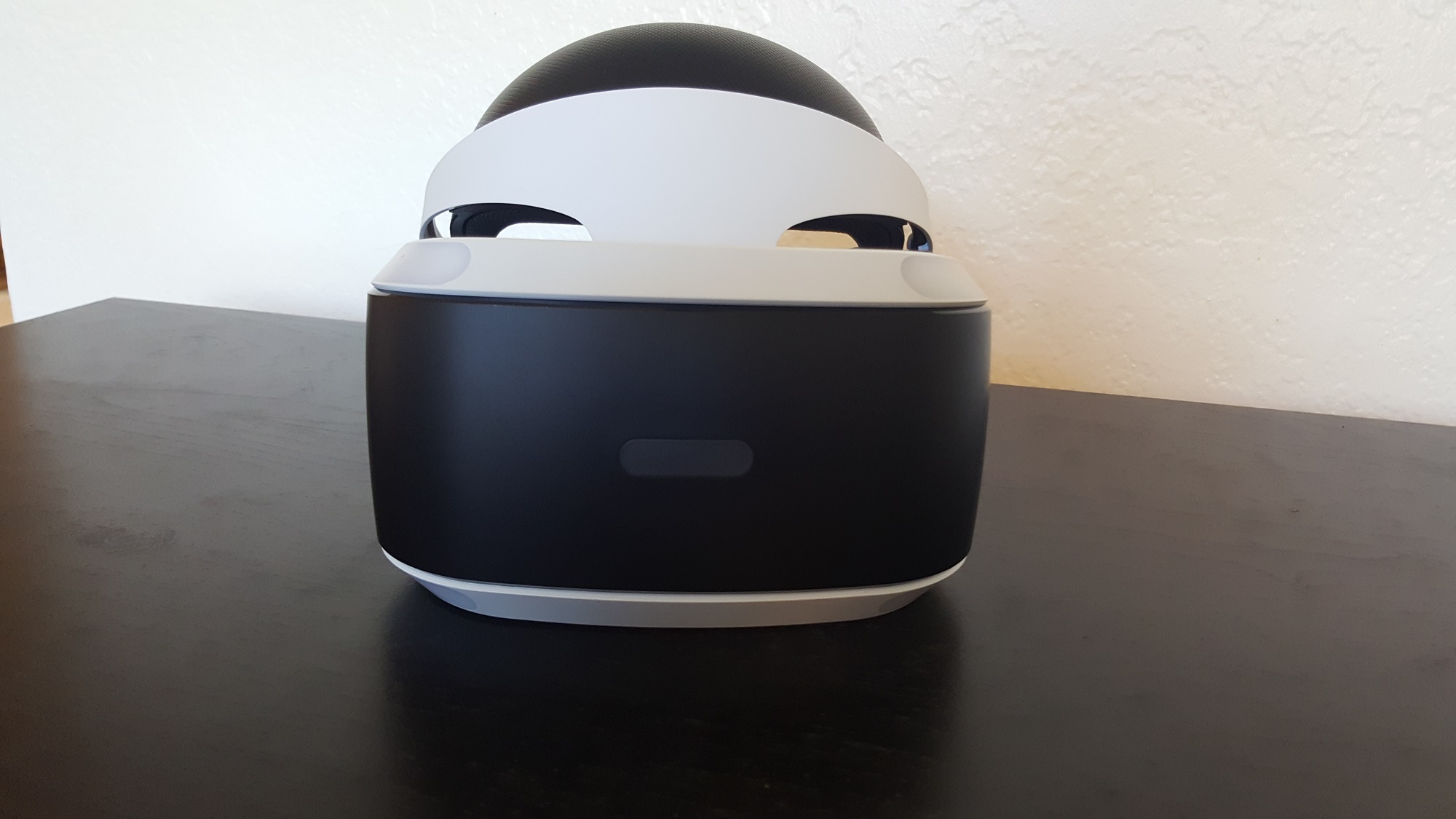
Ergonomics and Design
When compared to the Oculus Rift and the HTC Vive, the PlayStation VR looks similar at first glance. There is a large hunk of material on the front that obscures the face of the user almost entirely, delivering a design that’s reminiscent of science fiction literature and films from years’ past. Sony continued that lineage — especially considering its original Project Morpheus moniker — and even made sure to include some fancy LED lights right on the headset itself.
However, the biggest difference between this and other headsets on the market is that it’s based on a headband design, rather than a strap that clamps the unit to your face. In the case of the Rift and the Vive, you’ll use a combination of velcro straps to tighten and loosen the headset to your face, with a cushion covering you that can often be difficult to get just right. As someone that wears glasses, it’s often uncomfortable and frustrating to use those headsets for more than a few minutes. I’ve discovered ways to make them feel comfy, but it’s not always easy.
In the case of the PS VR, you simply place the ring of the headband on top of your head, slide the back part downward so it sits on your cranium at an angle, with the forehead pad gently resting atop your face. The material feels similar to a reptile’s skin, but it’s much softer and glossier. It also doesn’t soak up sweat as easily. Press the button on the back to loosen and tighten, twist the nob to fine-tune, and then press the button underneath the headset to slide the actual lenses closer or farther away from your eyeballs. That’s it.
That all adds up to one of the most comfortable and easy to use VR headsets created to date. The simple sliding of the lenses makes it beyond easy to peak out from the VR world to check your phone, inspect your surroundings, or just let your face breathe a bit. Much easier than having to unstrap or rip off the other headsets on the market.
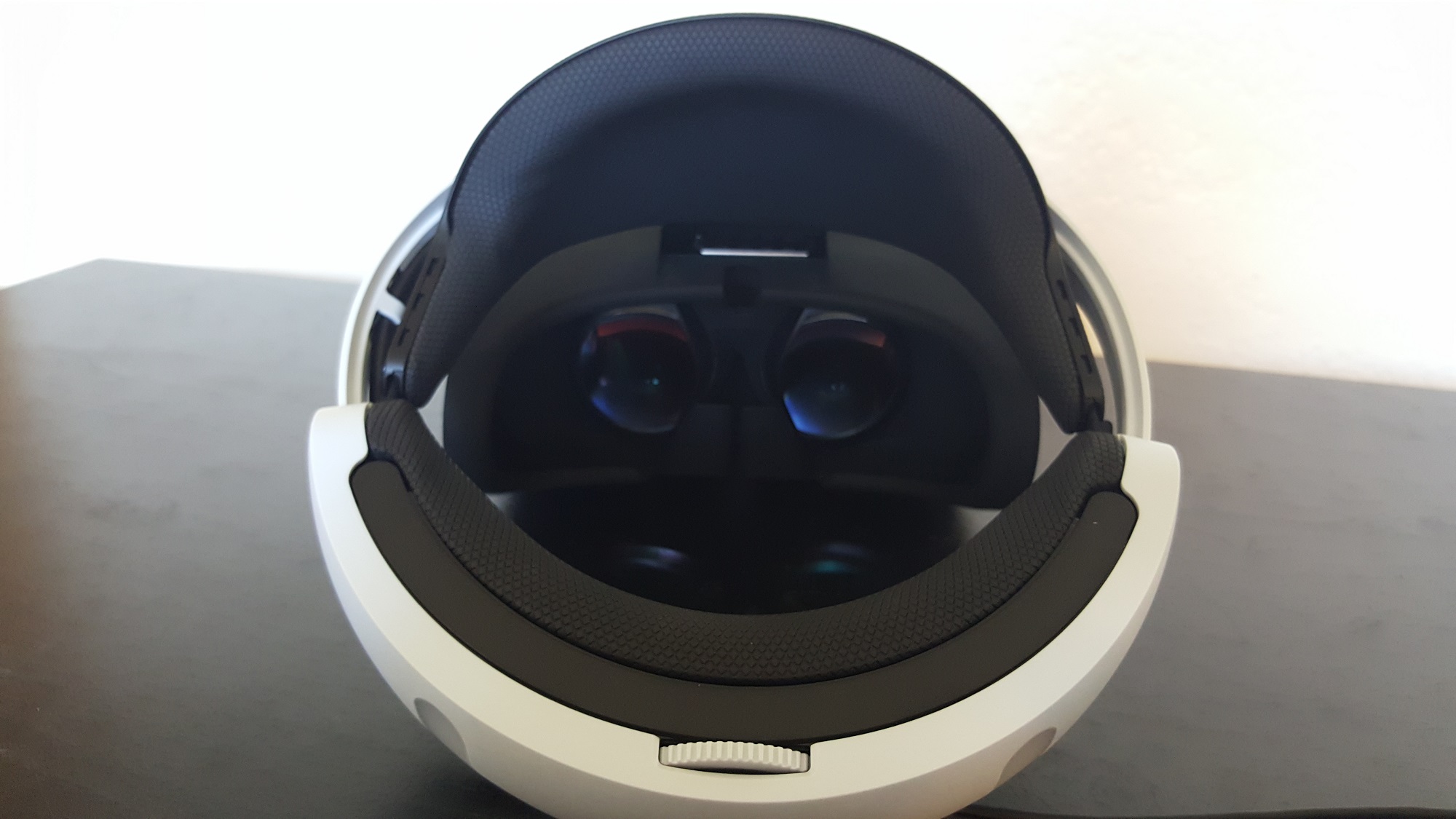
In terms of comfort, long sessions were never an issue for me as long as I put the headset on correctly. Since the headset weighs about 12.9oz, if you don’t slide the back part down and keep it adjusted on your face, the pieces at the back where the two halves connect can press against your temples and become uncomfortable.
But that wasn’t an issue if I, as I said, put it on correctly. It never bothered my neck, despite the fact that it’s incredibly top heavy like other headsets.
I did notice that the lenses tended to fog up more frequently than the Rift or Vive, which is likely due to the fact that when not in use, the headset got cold while unplugged from my game console. It didn’t sustain a constant warm connection. But since it comes with a microfiber cloth and the sliding lens design makes it so easy to reach up and wipe the lenses, it didn’t really bother me much. After about 5 minutes of use, fogging stopped being an issue.
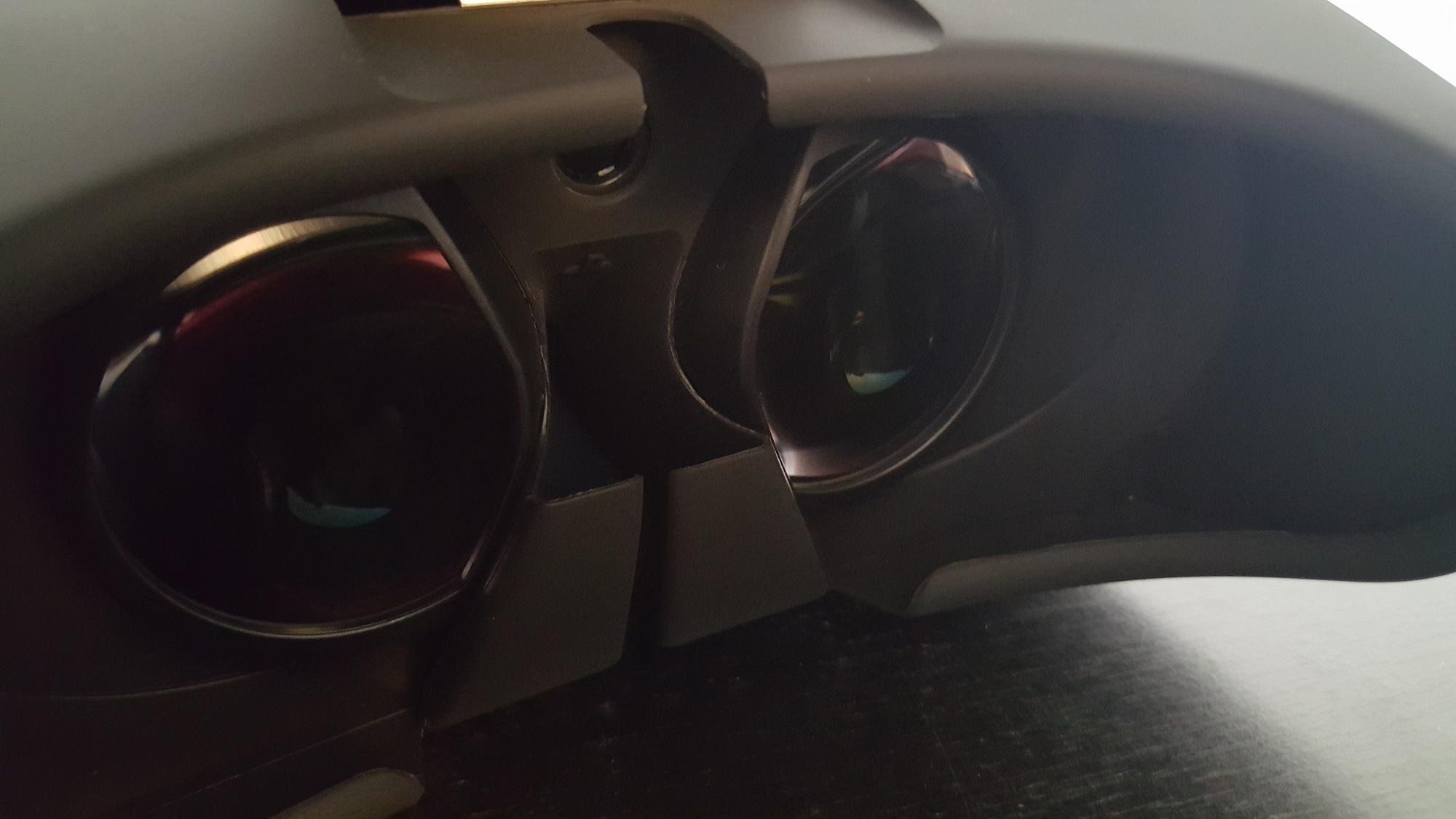
Display and Optics
The PlayStation VR uses a single 5.7” 1920 x 1080 resolution full-color OLED RGB display split between two eyes to deliver stereoscopic 3D content. The display refreshes at a rate of either 90Hz or 120Hz, depending on the application itself, with a latency of less than 18 milliseconds.
That’s the nitty gritty details, but what you really want to know is what it’s like to actually use. In my experience, the visual fidelity was great. Obviously, you can tell a difference between the clarity of the PS VR when compared side-by-side with the HTC Vive or Oculus Rift, but the difference is, overall, not very dramatic. Objectively, the PS VR is a lesser experience, but subjectively, it didn’t equate to a noticeable impact on my entertainment.
That being said, there are areas that present a downgrade in terms of overall resolution and FOV. The Oculus Rift and HTC Vive both feature a 2160 x 1200 display with a 110 degree field of view (FOV,) whereas the PlayStation VR is only 1920 x 1080 with a 100-degree FOV. To put that more plainly, the Rift and Vive both have more pixels in their screens and a wider area for viewing content. That means sharper images and less black space on the outskirts of the viewing area. Clearer imagery and larger vision add up to increased immersion.
After spending time in the PS VR, the decreased FOV and lower resolution stopped bothering me, but coming from the higher-powered headsets initially, it was apparent enough to point out.
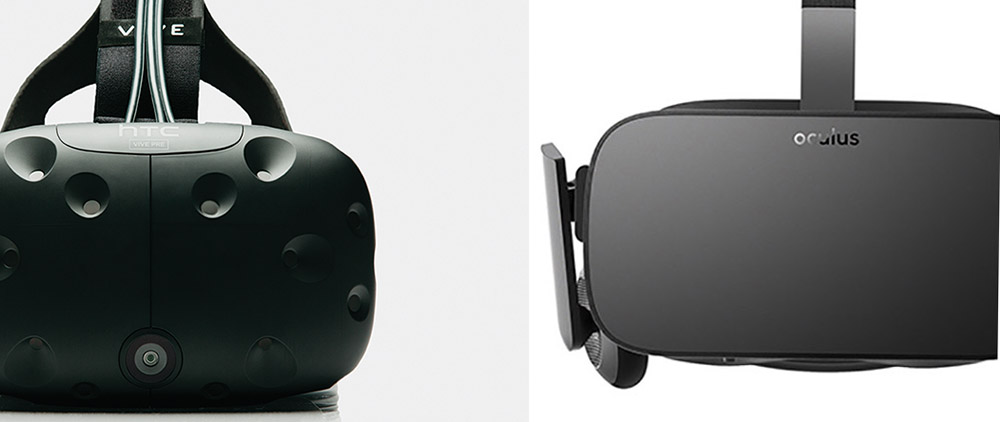
Depending on the application, resolution become a bit of an issue. When playing DriveClub VR on the provided demo disc for example, I had a lot of trouble reading the gauges on my car’s dashboard. Even if I leaned in to get a closer look, the numbers were fuzzy and it was difficult to decipher. The same goes for street signs I passed during a car chase scene in The London Heist on PlayStation VR Worlds. None of these things were really necessary for my enjoyment of the game’s in question, but the lack of fidelity was relatively obvious.
At the end of the day, when I wasn’t examining aspects of games to see how their clarity holds up and I instead decided to focus on playing the games and having a good time, my eyes glossed over the inefficiencies.
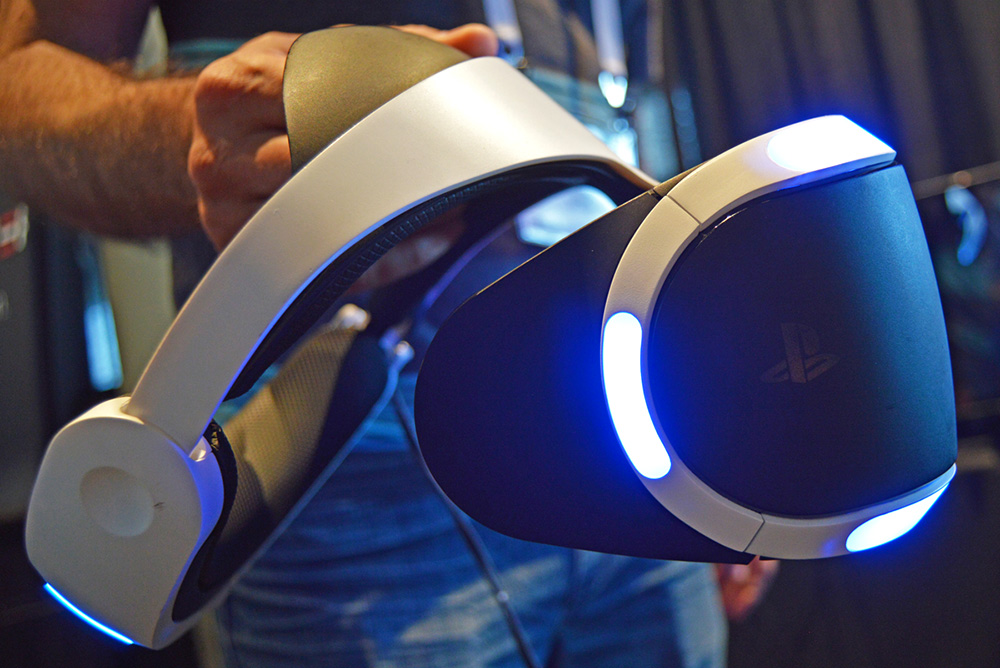
Sound
While the concept of virtual reality may seem like a primarily visual experience, the truth is that sound is just as important in delivering an immersive piece of content. Through the usage of audio cues in games, developers can get you to turn in certain directions, or video producers can make you feel even more immersed in a space than ever before. The sound of the wind at your back, howling beasts in a distant direction, and more are powerful tools at the disposal of content creators.
The power of 3D spatial audio is impressive and while it seems similar to just surround sound generally, when paired with an immersive 360-degree digital world that reacts to your head’s movement, it feels like you’ve truly been transported somewhere else.
And as an added bonus, the headphone jack on the PlayStation VR’s inline button unit is quick and easy to use. Just plug any headphones you have — whether they be the pre-packaged earbuds, or a comfy set you have lying around — and the 3D audio is baked in. The Processor Unit and headset itself transmit the 3D audio signal, so all you need to do is plug some headphones in. The inline unit also lets you power on and off the headset, as well as adjust the audio at the press of a few buttons. That is, as long as they’re wired. Wireless audio signals don’t carry 3D audio well.
Finally, yes — the PS VR does have a built-in microphone. The sound clarity is great when playing multiplayer games and it delivers a crystal-clear sound to your headphones of choice.
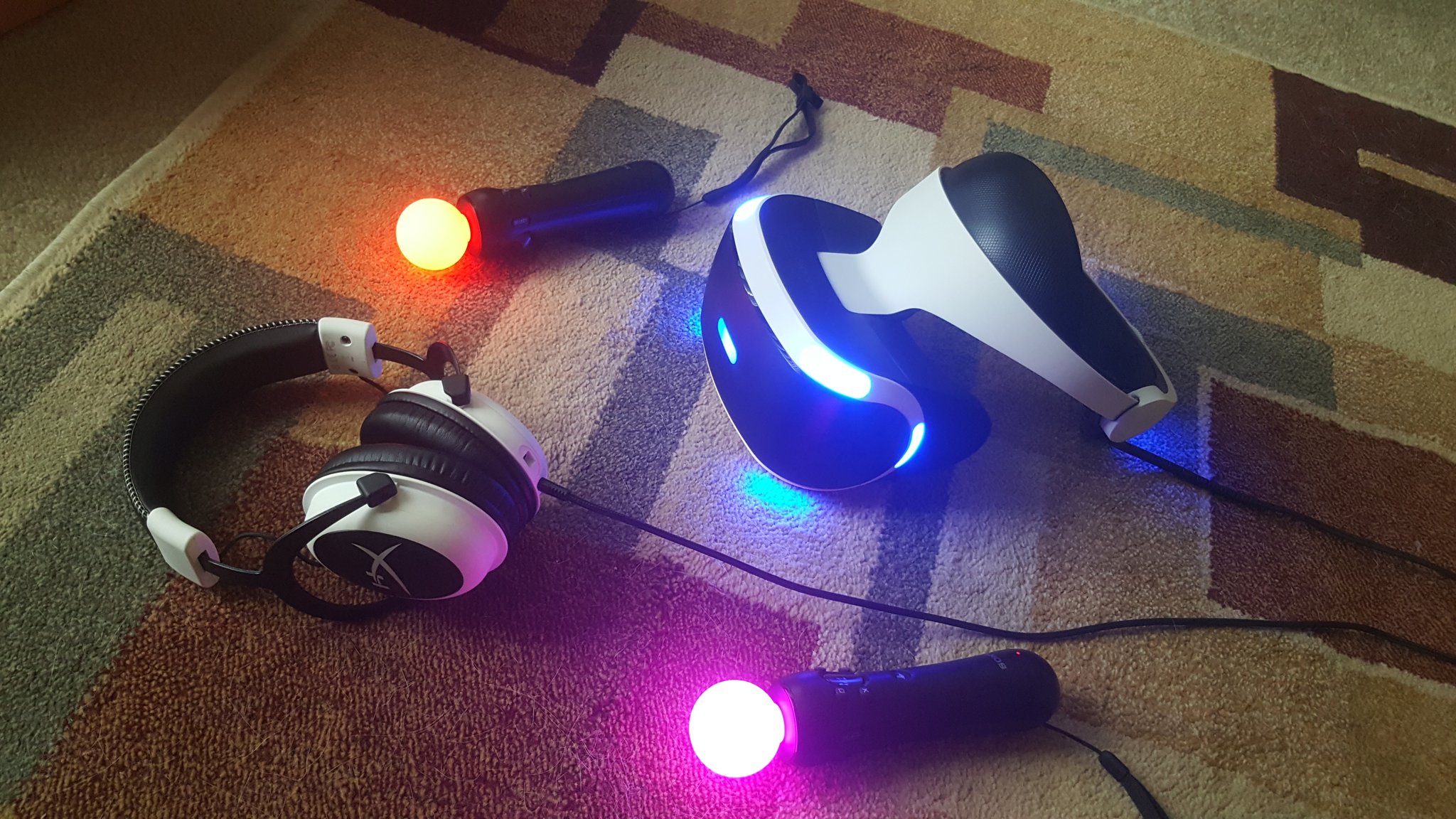
PlayStation Camera Tracking and Controllers
The bright lights might seem distracting at first, but rest assured you won’t even notice they’re there when you’re inside the headset. The PlayStation Camera, while having a normal lens, can’t accurately track your movement based on its vision alone. Instead, it tracks the LED lights found on the front and back of your headset, as well as the ones on the top of the Dualshock 4 controller and the PlayStation Move wands.
The camera sits at the top of your television and should be pointed directly at the center of your playspace, squarely on the headset itself. That orientation helps the camera establish your location in relation to the rest of the environment.
Ultimately, it gets the job done for the most part, but is a far cry from the Vive’s lighthouse base stations, or even the Rift’s tracking cameras. Simply put, the PlayStation Camera is dated and likely wasn’t created necessarily with VR in mind. After an hour or two of play, I noticed my orientation started to ‘drift’ to one side, causing me to slowly shift my seating position. After removing my headset, I noticed I was facing at an approximate 25-degree or so angle to the left of where the camera actually was located. It’s like the entire VR experience was slowly shifting over-time.
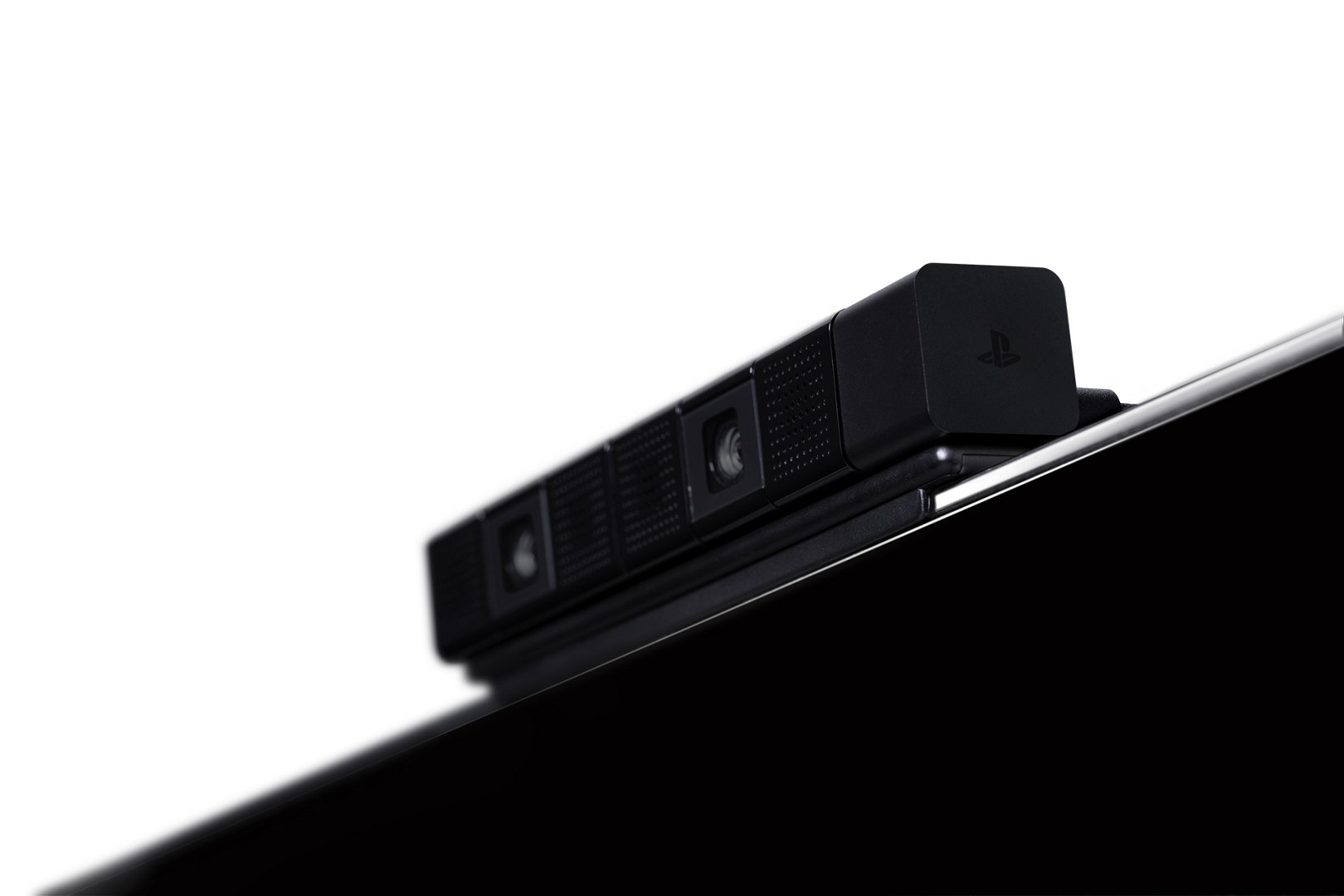
Additionally, it had trouble keeping up if I turned around while standing or in a swivel chair. Some games, such as Job Simulator or even Batman: Arkham VR, encourage standing, so I wasn’t exactly pushing the device outside its limits. If I had my back turned to the camera, it tracked my headset fine, but would occasionally lose track of the controllers while obstructed. This happened if my hands were out in front of me and not to my sides — it seemed like my body was shielding the camera’s signal. I’ll be curious to see how — or if — Sony can address that at all.
To be clear: these bumps in the road weren’t frequent and they didn’t actively disrupt my ability to play games. The Vive and Rift have tracking hiccups all the time, so this is far from an isolated issue.
Placing those unfortunate concerns aside, everything worked well when it needed to. When I was sitting upright, in the middle of my room, in normal conditions holding a controller in my hand for gameplay, the PS VR experience was at its best. The more sophisticated I tried to get — using motion controllers, moving around, turning, etc. — the less accurate the tracking became over time.
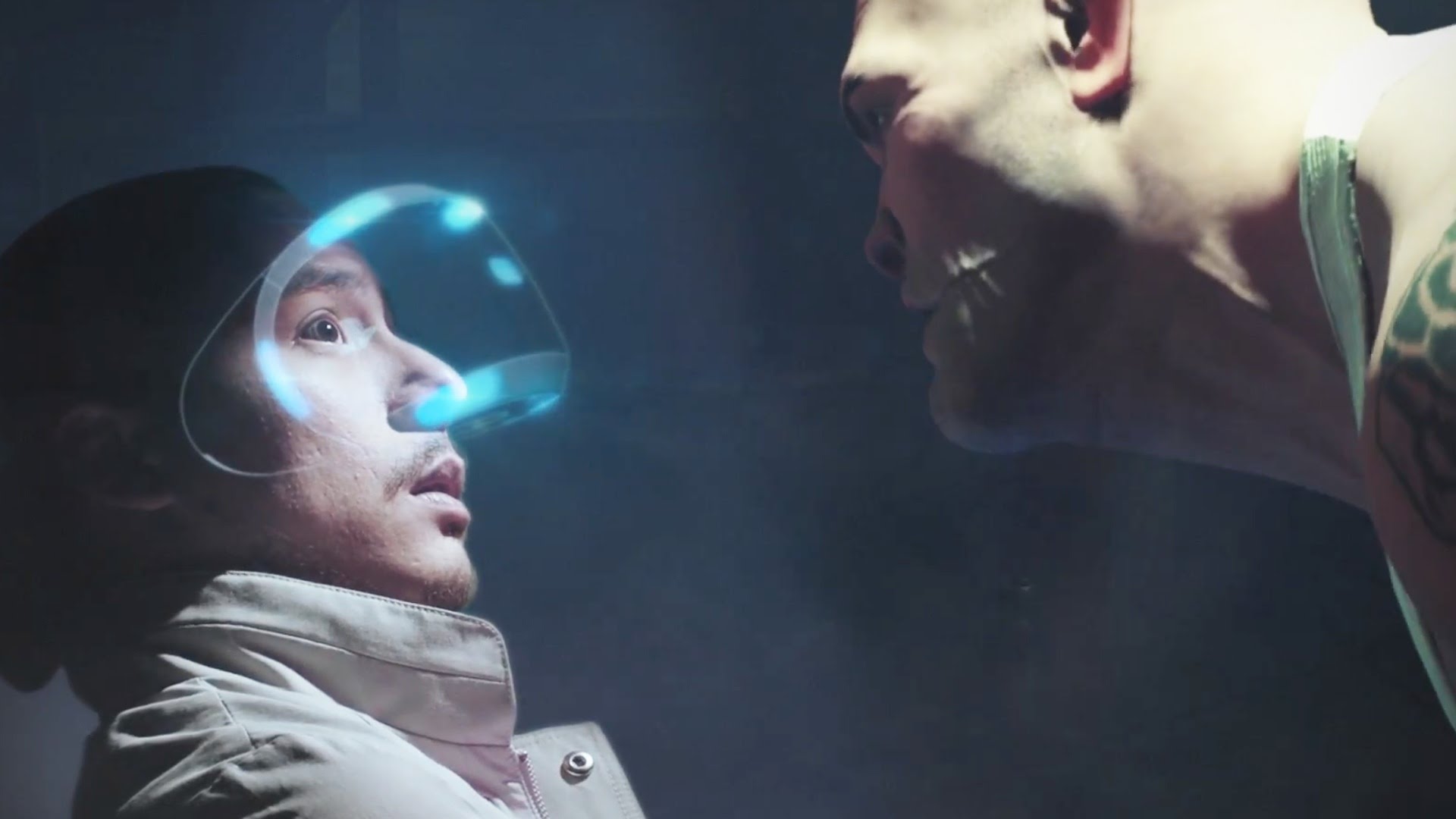
The Games
As they always say, software sells hardware. The PS VR headset, as impressive and nifty as it is, is frankly quite useless without software to use. Luckily, we’ve been promised approximately 50 titles to be released with PS VR support before the end of the year and we’ve been counting down to the release of the headset, highlighting a different game each day, for almost two full months in our article series.
The analysis in this section of this review will be light, as you can read the specific game reviews for more detailed thoughts, but this will provide an overview of the general landscape. We also haven’t had the ability to go hands-on with every launch title, but we do have an opinion piece about the headset from the POV of a hardcore console gamer’s perspective you should check out.
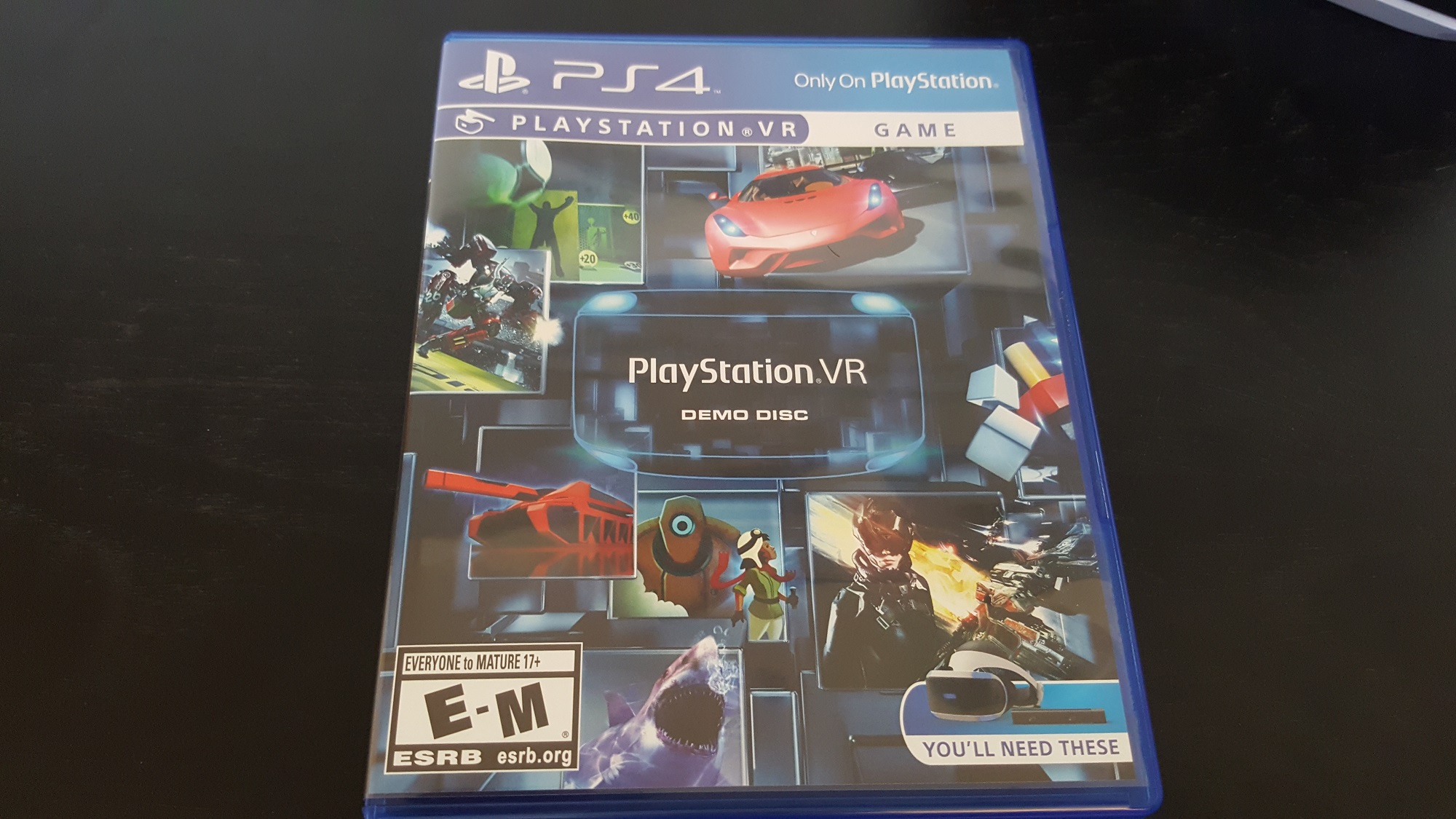
The Demo Disc
The demo disc is a forgotten art in today’s game industry, but Sony didn’t follow that trend. Instead, for US consumers, they’ve packed in over two dozen short demos to give you a varied and robust taste of what the headset has to offer. Headsets in other territories come with fewer demos. On this demo disc, you can take flight in the cockpit of a space fighter in EVE: Valkyrie, get behind the wheel of some of the world’s fastest cars with DriveClub VR, fire away at enemies in your tank with Battlezone, and even experience the torturous Kitchen demo from Capcom.
While it’s not saying much, it wouldn’t be an understatement to rank this as perhaps one of the best demo discs ever created. There is a tremendous amount of variety and enough content to keep you busy for literally hours on end just to see everything the disc has to offer. If you fall in love with something on the disc, going to the full game’s store page for a quick purchase and download is just a single button away. This should be the starting point for all new PS VR owners.
The Playroom VR will also be a free download for anyone to grab off of the PlayStation Store, but it wasn’t playable yet as of the time of this review.
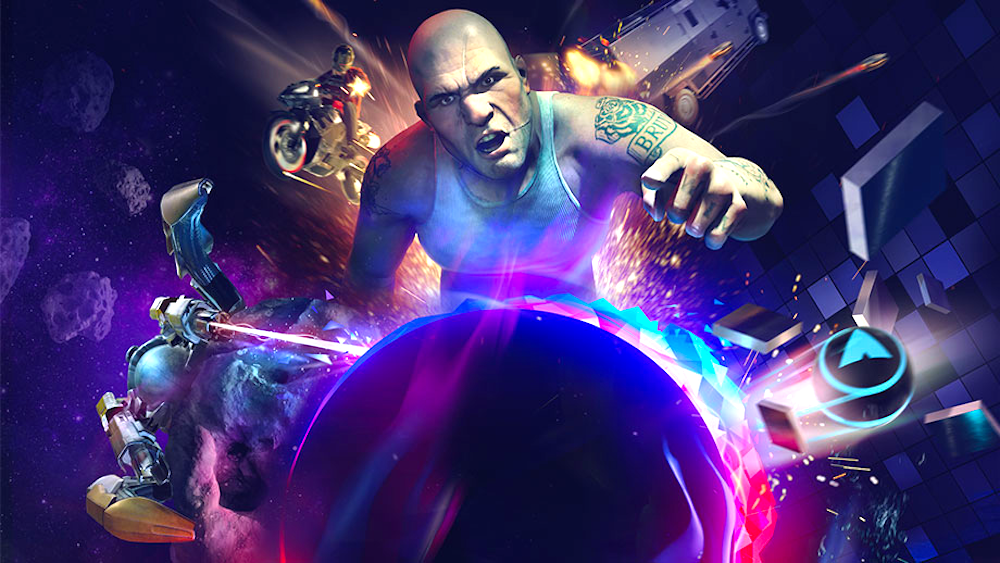
PlayStation VR Worlds
If you get the launch bundle that includes the headset, camera, Move controllers, and PlayStation VR Worlds, you’re in for a treat here as well. This bundle game contains five short experiences that are each a step above being ‘demos’ but not quite worthy of being released as fully independent titles. The London Heist is an excellent action-packed adventure that features heavy violence, first-person shooting, and a gripping interrogation scene. Dangerball is just like playing Pong, except your face is the paddle. VR Luge is one of the most intense racing games I’ve played in VR yet, rocketing you down busy streets as you dodge and weave between vehicles. Ocean Descent lets you get up close and person with a shark and, finally, Scavengers Odyssey is part mech-combat and part space shooter.
As stated, each of these games on their own wouldn’t warrant much, but as a package, it’s a deeper dive into what more complete games and experiences could look like. If the Demo Disc is your introductory course in what the PS VR can do, consider this your intermediate course before you graduate without training wheels.
What About the ‘Actual’ Games?
There are a lot of games coming to PS VR this year — remember, we said around 50 — and we frankly haven’t had time to play them all yet. In fact, many of them haven’t even been provided to media yet for review. As of the time of this writing, we at UploadVR have only been provided review copies of Allumette, Batman: Arkham VR, PlayStation VR Worlds, Battlezone, Harmonix Music VR, Job Simulator, SUPERHYPERCUBE, Tumble VR, Until Dawn: Rush of Blood, Wayward Sky, and Thumper. Heavy hitters like RIGS, Robinson: The Journey, EVE: Valkyrie, DriveClub VR, and more haven’t been provided as of the time of this publication.
However, we’ve played the listed games quite a lot. In fact, if you’re reading this right now, then many of our reviews for those PS VR games are live and you can see them either at the hyperlinks above, or by visiting the site’s Reviews tab.
Suffice it to say that if you’re interested in getting a PS VR, then yes, we think that the launch lineup of games is strong enough to warrant the purchase. And if you already have the required PlayStation Camera and/or optional Move controllers with your PlayStation 4 now, then that decision should be even easier to make.
Other Features and Topics
The analysis doesn’t stop there. In addition to playing dedicated PlayStation VR games like the ones mentioned above, you can do a whole lot of other stuff inside Sony’s flagship headset as well. For example, Cinematic Mode lets you access anything else on your PS4 within a private cinema. This is great for watching movies on a large, virtual screen, or playing non-VR games inside the headset. The PS VR will also function perfectly fine while others in the room are using the TV for something else.
And whilst you’re inside VR, everyone else around you can still see what you’re seeing if they want, albeit on a downgraded, flat, 2D screen. This is nifty so that everyone else in the room doesn’t feel completely left out. Plus, some games such as The Playroom VR or Tumble VR, utilize this feature for local multiplayer.
You’ll also be able to share and stream content that you’re seeing inside the PS VR headset using your PS4’s built-in Share button functionality.
Greatness Awaits
The PlayStation VR headset is far from a perfect device. Tracking has its issues with the dated PlayStation Camera and Move controllers and the visual fidelity is lower than that of its primary competitors, but what it lacks in technical prowess it makes up for in accessibility, affordability, and a streamlined focus on quality content.
This may not be the most technologically advanced headset on the market, but for console gamers that want a taste of the power and potential of virtual reality, it’s hard not to recommend what Sony has created. I don’t think VR will completely replace traditional video games, but it’s a format that is finally matured enough to stick around.
With PlayStation VR, the future of console gaming has finally arrived.

